1. ΉΕε Έκι
Ή╡εΆ╖╝ Ά╡φΈΓ┤ΉΩΡΉΕεΈΛΦ ΉΜεΆ░ΕΈΜ╣ 50 mm Ήζ┤ΉΔΒ, 1Ήζ╝ 300 mm Ήζ┤ΉΔΒΉζα ΉπΣΉνΣΊα╕Ήγ░ Έ░εΉΔζΈ╣ΙΈΠΕΆ░Α Ά╕ΚΆ▓σΊΧαΆ▓Ν ΉοζΆ░ΑΊΧαΆ│ι ΉηΙΈΜν. ΉΜνΉιεΈκε Ά╡φΈο╜Ά╕░ΉΔΒΆ│╝ΊΧβΉδΡ(
NIMS, 2018)ΉΩΡΉΕε ΉΩ░Ά╡υΊΧε ΈΓ┤ΉγσΉΩΡ ΈΦ░Έξ┤Έσ┤ 1912ΈΖΕΈ╢ΑΊΕ░ 2017ΈΖΕΆ╣ΝΉπΑ Ά╡φΈΓ┤ΉΩΡΉΕε Έ░εΉΔζΊΧε Ά░ΧΉΙαΈθΚΉζΑ 10ΈΖΕ Ά░ΕΆ▓σΉε╝Έκε 16.3 mmΉΦσ ΉοζΆ░ΑΊΧαΆ│ι ΉηΙΈΛΦ Ή╢ΦΉΕ╕Ήζ┤ΈΜν. Ήζ┤Έθ░ ΉΔΒΊβσΉΩΡΉΕε Ήμ╝Ά▒░Ά▒┤Έυ╝Ά│╝ ΉΓυΊγΝΆ╕░Έ░αΉΜεΉΕν ΈΥ▒Ήζ┤ Έ░ΑΉπΣΈΡαΉΨ┤ ΉηΙΈΛΦ ΈΠΕΉΜεΉπΑΉΩφΉΩΡ ΊβΞΉΙαΆ░Α Έ░εΉΔζΊΧι Ά▓╜Ήγ░ Ήζ╕ΈςΖ Έ░Π ΉηυΉΓ░ ΊΦ╝ΊΧ┤ΈΛΦ Ά╕░ΊΧαΆ╕ΚΉΙαΉιΒΉε╝Έκε Ή╗νΉπΑΆ▓Ν ΈΡεΈΜν. Ήζ┤ΉΩΡ ΈΦ░Έζ╝ ΊΨΚΉιΧΉΧΙΉιΕΈ╢ΑΉΩΡΉΕεΈΛΦ ΉηΡΉΩ░ΉηυΊΧ┤Έκε Ήζ╕ΊΧε ΊΦ╝ΊΧ┤Έξ╝ ΉιΑΆ░ΡΊΧαΈΛΦ Έ░σΉηυΈΝΑΉ▒ΖΉζα Ήζ╝ΊβαΉε╝Έκε ΉπΑΉΩφΉΧΙΉιΕΉπΑΉΙαΉβΑ ΉπΑΉΩφΉΧΙΉιΕΈΠΕΉβΑ Ά░βΉζΑ ΉπΑΉηΡΉ▓┤Έ│Ε ΉεΕΊΩαΈΠΕ ΊΠΚΆ░ΑΈξ╝ ΈπνΈΖΕ ΉΜνΉΜεΊΧαΆ│ι ΉηΙΈΜν. ΊΧαΉπΑΈπΝ, ΉπΑΉΩφΉΧΙΉιΕΉπΑΉΙαΈΛΦ Ά╡ΡΊΗ╡ΉΓυΆ│ι, Έ▓ΦΉμΕ, ΉιΕΉΩ╝Έ│Σ ΈΥ▒ ΉπΑΉηΡΉ▓┤ ΉεΕΊΩαΆ│╝ Ά┤ΑΈιρΈΡε ΈΜνΉΨΣΊΧε ΉΕ╕Έ╢ΑΉπΑΊΣεΈξ╝ ΉΓυΉγσΊΧαΉΩυ ΈΠΕΉ╢εΈΡε ΉπΑΉΙαΉζ┤Ά╕░ ΈΧΝΈυ╕ΉΩΡ ΊβΞΉΙαΉεΕΊΩαΆ│╝Ήζα ΉΩ░Ά┤ΑΉΕ▒Ήζ┤ ΉιΒΈΜν. ΉπΑΉΩφΉΧΙΉιΕΈΠΕΈΠΕ ΊβΞΉΙαΈ┐ΡΈπΝ ΉΧΕΈΜΙΈζ╝ ΊΤΞΉΙαΊΧ┤ ΉιΕΈ░αΉΩΡ Ά▒╕Ή╣ε ΊΠΚΆ░ΑΆ░Α Ήζ┤ΈμρΉΨ┤ΉπΑΆ│ι ΉηΙΉε╝Έσ░, ΊΨΚΉιΧΉΩΖΈυ┤ ΉΙαΊΨΚΈΛξΈιξ ΈΥ▒ΈΠΕ ΊΠΚΆ░ΑΉΩΡ Έ░αΉαΒΈΡαΆ╕░ ΈΧΝΈυ╕ΉΩΡ ΉπΑΉηΡΉ▓┤Έ│Ε ΊβΞΉΙαΉεΕΊΩαΉΩΡ ΈΝΑΊΧε Έ░σΉηυΉΩφΈθΚ ΊΠΚΆ░ΑΆ░Α ΉιεΈΝΑΈκε Ήζ┤ΈμρΉΨ┤ΉπΑΆ│ι ΉηΙΈΛΦΉπΑΉΩΡ ΈΝΑΊΧ┤ ΉζαΈυ╕ΉιΡΉζΕ Ά░ΑΉπΑΆ│ι ΉηΙΈΜν. ΈΦ░Έζ╝ΉΕε ΊΔΑΈΜ╣ΉΕ▒ ΉηΙΈΛΦ ΊβΞΉΙαΉεΕΊΩαΈΠΕ ΊΠΚΆ░ΑΆ░Α Ήζ┤ΈμρΉΨ┤ΉπΑΆ╕░ ΉεΕΊΧ┤ΉΕι Ά┤ΑΈιρ ΉΕ╕Έ╢ΑΉπΑΊΣεΈξ╝ ΉΕιΈ│ΕΊΧε ΊδΕ Ή╣ρΉΙαΊΦ╝ΊΧ┤ ΉαΒΊΨξΈ▓ΦΉεΕΉΩΡ ΈΥνΉΨ┤ΉανΈΛΦ ΉΕ╕Έ╢ΑΉπΑΊΣεΈ│Ε ΊΗ╡Ά│ΕΆ░Τ ΈπΝΉζΕ Ή╢ΦΉ╢εΊΧαΉΩυ ΊΠΚΆ░ΑΉΩΡ Έ░αΉαΒΊΧι ΊΧΕΉγΦΆ░Α ΉηΙΈΜν.
Ά╡φΈΓ┤ΉΩΡΉΕε ΉπΕΊΨΚΈΡε ΊβΞΉΙαΉεΕΊΩαΈΠΕ ΊΠΚΆ░Α ΉΓυΈκΑΈξ╝ ΉΓ┤ΊΟ┤Έ│┤Έσ┤,
Kim et al. (2012)ΉΩΡΉΕεΈΛΦ Ή╣ρΉΙαΉ╖ρΉΧ╜ΉΕ▒ ΊΠΚΆ░ΑΈξ╝ ΉεΕΊΧ┤ ΊΠΚΆ░ΑΊΧφΈςσΉζΕ Ά╕░ΊδΕ, ΉΙαΈυ╕ΉπΑΉπΙ, ΉΓυΊγΝΆ▓╜Ήιε, Έ░σΉΨ┤Έκε Ά╡υΈ╢ΕΊΧαΆ│ι, Ά░ΧΉγ░Έ╣ΙΈΠΕ, Ή╣ρΉΙαΊζΦΉιΒΈΠΕ, ΉηυΉιΧΉηΡΈο╜ΈΠΕ ΈΥ▒ 9Ά░ΑΉπΑ ΉΕ╕Έ╢Α ΉπΑΊΣεΈξ╝ ΉΕιΉιΧΊΧαΉΩυ ΊΠΚΆ░ΑΈξ╝ ΉπΕΊΨΚΊΧαΉαΑΈΜν.
Kim et al. (2013)ΉζΑ ΊβΞΉΙα Ή╖ρΉΧ╜ΉΕ▒ΉΩΡ ΈΝΑΊΧε Ά╡υΉΕ▒ΉγΦΉΗΝΈξ╝ Ά╕░ΊδΕΉγΦΉζ╕, Έψ╝Ά░ΡΈΠΕ, ΉιΒΉζΣΈΠΕΈκε Έ╢ΕΈξαΊΧε ΊδΕ 1Ήζ╝ Ή╡εΈΝΑΆ░ΧΉγ░ΈθΚ, Ήζ╕Ά╡υΈ░ΑΈΠΕ, ΉηυΉιΧΉηΡΈο╜ΈΠΕ ΈΥ▒ 15Ά░εΉζα ΈΝΑΊΣεΈ│ΑΉΙαΈξ╝ ΉΕιΉιΧΊΧαΉΩυ ΉΕεΉγ╕ΉΜε ΊΨΚΉιΧΈΠβΈ│Ε ΊβΞΉΙα Ή╖ρΉΧ╜ΉΕ▒ΉζΕ Έ╢ΕΉΕζΊΧαΉαΑΈΜν.
Lee et al. (2019)ΉζΑ ΉιΕΆ╡φ 228Ά░ε ΉΜεΆ╡░Ά╡υΈξ╝ ΈΝΑΉΔΒΉε╝Έκε Ή╡εΆ╖╝ 20ΈΖΕΆ░Ε ΉηυΊΧ┤ΉΩ░Έ│┤ΉΩΡ Ά╕░ΉηυΈΡε Ά│╝Ά▒░ ΉηΡΉΩ░ΉηυΈΓε Έ░εΉΔζΊγθΉΙα, Ήζ┤ΉηυΈψ╝ΉΙα, ΉΓυΈπζέΜΖΉΜνΉλΖΉηΡΉΙα ΈΥ▒ΉζΕ ΉεΕΊΧ┤ΉΕ▒, ΈΖ╕Ή╢εΉΕ▒ ΉπΑΊΣεΈκε ΉΓυΉγσΊΧαΉαΑΈΜν. ΈαΡΊΧε ΉζαΈμΝΉιΒ ΉγΦΉζ╕, ΊΨΚΉιΧΉιΒ ΉγΦΉζ╕, ΉιΧΉ▒ΖΉιΒ ΉγΦΉζ╕ ΈΥ▒ΉζΕ ΉιΑΆ░ΡΉΕ▒ ΉπΑΊΣεΈκε ΉΓυΉγσΊΧαΉΩυ ΉηΡΉΩ░ΉηυΈΓεΉΩΡ ΈΝΑΊΧε ΉεΕΊΩαΉΕ▒ ΊΠΚΆ░ΑΈξ╝ ΉΙαΊΨΚΊΧαΉαΑΈΜν.
Han et al. (2015)ΉΩΡΉΕεΈΛΦ Ά░ΧΉγ░, ΊΔεΊΤΞ, ΊβΞΉΙαΈ▓ΦΈηΝΉε╝Έκε Έ░εΉΔζΊΧαΈΛΦ Έ│╡ΊΧσΉεΕΊΩαΉγΦΉΗΝΉΩΡ ΈΝΑΊΧ┤ Ήζ╕Ή▓εΉπΑΉΩφΉζΕ ΈΝΑΉΔΒΉε╝Έκε ΉηυΊΧ┤ΉεΕΊΩαΉπΑΉΙαΈξ╝ ΉΓ░ΉιΧΊΧαΉαΑΈΜν. ΊΧ┤ΈΜ╣ ΉπΑΉΙαΈΛΦ ΉεΕΊΩαΉΕ▒, ΈΖ╕Ή╢εΉΕ▒, Ή╖ρΉΧ╜ΉΕ▒, ΈΝΑΉζΣέΜΖΈ│╡Ά╡υΉΕ▒ ΉγΦΉΗΝΈκε Ά╡υΉΕ▒ΈΡαΉΨ┤ ΉηΙΉε╝Έσ░, ΈΠΕΉΜεΉπΑΉΩφΉζα ΉηυΊΧ┤ΉεΕΊΩαΈΠΕΈξ╝ ΊΠΚΆ░ΑΊΧαΈΛΦ Έ░σΉΧΙΉζΕ ΉιεΉΜεΊΧαΉαΑΈΜν.
ΊΧ┤Ήβ╕Ήζα Ά▓╜Ήγ░
Bollin et al. (2003)ΉζΑ Community Based Indicator SystemΉζΕ Ά╡υΉ╢ΧΊΧαΉΩυ ΉπΑΉΩφΈ│Ε ΉεΕΊΩαΈΠΕΈξ╝ ΊΠΚΆ░ΑΊΧαΆ╕░ ΉεΕΊΧε 4Ά░εΉζα ΊΧφΈςσ(Hazard, Exposure, Vulnerability, Capacity & measures)Ά│╝ 47Ά░εΉζα ΉΕ╕Έ╢ΑΉπΑΊΣεΈξ╝ ΉΓυΉγσΊΧαΉαΑΈΜν. ΊΧ┤ΈΜ╣ Έ░σΈ▓ΧΈκιΉζΑ Caribbean handbookΉΩΡΉΕε ΉιεΉΜεΊΧε Indicator Based Approach (IBA)ΉβΑ ΈΠβΉζ╝ΊΧε Έ░σΈ▓ΧΈκιΉζΕ ΉΓυΉγσΊΧαΉΩυ ΉπΑΉΩφΈ│Ε ΉΔΒΈΝΑΉιΒΉζ╕ ΉεΕΊΩαΈΠΕΈξ╝ ΊΠΚΆ░ΑΊΧι ΉΙα ΉηΙΈΜν.
Dwyer et al. (2004)ΉΩΡΉΕεΈΛΦ ΉηυΈΓεΉΩΡ ΈΝΑΊΧε Έ░εΉΔζΊβΧΈξι, ΉηυΈΓε ΊΦ╝ΊΧ┤ΉΩΡ ΈΝΑΊΧε ΈΖ╕Ή╢ε ΉιΧΈΠΕ, ΉηυΈΓε ΈΝΑΉζΣ Έ╢ΑΉκ▒ΉΩΡ ΈΝΑΊΧε ΊΛ╣ΉΕ▒ΉζΕ Ά░ΒΆ░Β ΉεΕΊΧ┤ΉΕ▒, ΈΖ╕Ή╢εΉΕ▒, Ή╖ρΉΧ╜ΉΕ▒ ΊΧφΈςσΉε╝Έκε Ά╡υΈ╢ΕΊΧαΉΩυ ΉεΕΊΩαΈΠΕ ΊΠΚΆ░ΑΈξ╝ ΉΙαΊΨΚΊΧαΉαΑΈΜν.
Flax et al. (2002)ΉζΑ Ά╡ΡΊΗ╡έΜΖΊΗ╡ΉΜιΉΜεΉΕν, ΉΔΒΊΧαΉΙαΈΠΕ, Έ│ΣΉδΡ, ΈΝΑΊΦ╝ΉΗΝ ΈΥ▒ Ήμ╝ΉγΦΉΜεΉΕνΉΩΡ ΈΝΑΊΧε ΉηυΊΧ┤ Ή╖ρΉΧ╜ΉΕ▒ ΊΠΚΆ░ΑΈςρΊαΧΉζΕ Ά░εΈ░εΊΧαΉΩυ ΉηυΊΧ┤ΉαΒΊΨξ Έ░Π Έυ╝ΈουΉιΒ Ή╖ρΉΧ╜ΉΕ▒ΉζΕ Ή╢ΦΉιΧΊΧαΉαΑΈΜν. ΈαΡΊΧε, ΉΛνΉ╜ΦΊΜΑΈηεΈΥε ΊβαΆ▓╜Έ│┤Ία╕Ά╡φ(Scottish Environment Protection Agency, SEPA)ΉΩΡΉΕεΈΛΦ National Flood Risk Assessment (NFRA)Έξ╝ Ά░εΈ░εΊΧαΉαΑΈΛΦΈΞ░, ΊβΞΉΙαΉεΕΊΩαΉπΑΈΠΕ Έ▓ΦΉεΕ ΈΓ┤ΉΩΡ ΉηΙΈΛΦ ΉΓυΈηΝ, Ά▓╜Ήιε, Έυ╕ΊβΦΉειΉΓ░ Έ░Π ΊβαΆ▓╜ΉΩΡ ΈΝΑΊΧε ΉπΑΊΣεΈ│Ε ΊΗ╡Ά│ΕΆ░ΤΉζΕ ΉΕιΈ│ΕΊΧαΉΩυ 1 km ├Ω 1 km Ά▓σΉηΡΉηΡΈμΝΈκε ΊβΞΉΙαΉεΕΊΩαΈΠΕΈξ╝ ΈΓαΊΔΑΈΓ┤ΉΩΙΈΜν(
SEPA, 2002).
Έ│╕ ΉΩ░Ά╡υΉΩΡΉΕεΈΛΦ IBA Ά╕░Έ░α Community Based Indicator SystemΉζα ΊΠΚΆ░ΑΈ░σΈ▓ΧΉζΕ Ή░╕Ά│ιΊΧαΉΩυ 4Ά░εΉζα ΊΠΚΆ░Α ΊΧφΈςσΉζ╕ Hazard, Exposure, Vulnerability, Capacity ΉνΣ ExposureΉΩΡ ΊΧ┤ΈΜ╣ΊΧαΈΛΦ Ά▒┤Ή╢ΧΈυ╝ΉΙαΈξ╝ ΈΝΑΉΔΒΉε╝Έκε Ά▓╜Ά╕░ΈΠΕ 31Ά░ε ΉΜεΆ╡░Έ│Ε ΉΕ╕Έ╢ΑΉπΑΊΣε ΉπΑΉΙαΈξ╝ ΉΓ░ΉιΧΊΧαΉαΑΈΜν. ΉπΑΉηΡΉ▓┤Έ│Ε Ά▒┤Ή╢ΧΈυ╝ΉΙα ΉΓ░ΉιΧΉζΑ 2018ΈΖΕ 11ΉδΦ Ά╕░ΉνΑ ΈΠΕΈκεΈςΖΉμ╝ΉΗΝ ΉιΕΉηΡΉπΑΈΠΕ(Ά▒┤Έυ╝)Ήζα Ά▒┤Έυ╝ ΊΠ┤ΈουΆ│ν shp ΊΝΝΉζ╝Ά│╝ Ά╡φΊΗιΊΗ╡Ά│ΕΉπΑΈΠΕΉΩΡΉΕε ΉιεΆ│╡ΊΧαΈΛΦ 500 m ├Ω 500 m Ά▒┤Ή╢ΧΈυ╝ΉΙα Ά▓σΉηΡΉηΡΈμΝΈξ╝ ΉΓυΉγσΊΧαΉαΑΈΜν. Ά│╡Ά░ΕΈ╢ΕΉΕζΉζΕ ΊΗ╡ΊΧ┤ ΉπΑΉηΡΉ▓┤Έ│Ε Ά▒┤Ή╢ΧΈυ╝ΉΙαΆ░Α ΉΓ░ΉιΧΈΡαΈσ┤, ΊβαΆ▓╜Έ╢ΑΉζα Ά╡φΆ░ΑΊΧαΉ▓ε, ΊΨΚΉιΧΉΧΙΉιΕΈ╢ΑΉζα ΉπΑΈ░σΊΧαΉ▓ε, ΉΗΝΊΧαΉ▓ε ΊβΞΉΙαΉεΕΊΩαΉπΑΈΠΕΈξ╝ ΉΓυΉγσΊΧαΉΩυ Ή╣ρΉΙαΊΦ╝ΊΧ┤ ΉαΒΊΨξΈ▓ΦΉεΕΉΩΡ ΈΥνΉΨ┤ΉανΈΛΦ Ά▒┤Έυ╝ΈΥνΉζΕ Ή╢ΦΉ╢εΊΧε ΊδΕ Ά▒┤Ή╢ΧΈυ╝ΉΙαΉΩΡ ΈΝΑΊΧε ΉπΑΉΙα ΉΓ░ΉιΧΉΩΡ Ή╡εΉλΖ Έ░αΉαΒΊΧαΉαΑΈΜν. Ά╡φΈΓ┤ Ά╕░Ήκ┤ ΉΩ░Ά╡υΉΩΡΉΕεΈΛΦ ΉηυΊΧ┤ΉΩΡ ΈΝΑΊΧε ΉεΕΊΩαΈΠΕΈξ╝ ΊΠΚΆ░ΑΊΧι ΈΧΝ ΊΗ╡Ά│ΕΉ▓φ Έ░Π ΉηυΊΧ┤ΉΩ░Έ│┤Ήζα ΊΗ╡Ά│ΕΉηΡΈμΝ, ΉπΑΉηΡΉ▓┤Έ│Ε Ή╣ρΉΙαΊζΦΉιΒΈΠΕ Έσ┤ΉιΒ ΈΥ▒ ΉΕ╕Έ╢ΑΉπΑΊΣεΈ│Ε ΈΜρΉΙε ΊΗ╡Ά│ΕΆ░ΤΈπΝΉζΕ ΉΓυΉγσΊΧαΉαΑΈΜν. Ήζ┤ Ά▓╜Ήγ░ ΉΕιΉιΧΈΡε ΉΕ╕Έ╢ΑΉπΑΊΣεΈΥνΉζα ΊΗ╡Ά│ΕΆ░ΤΉζ┤ ΉΜνΉιε ΊβΞΉΙαΉεΕΊΩαΈΠΕΉβΑ ΉΨ┤ΈΛΡ ΉιΧΈΠΕΉζα ΉΩ░Ά┤ΑΉΕ▒ΉζΕ Ά░ΑΉπΑΆ│ι ΉηΙΈΛΦΉπΑ ΉιεΈΝΑΈκε Έ│┤ΉΩυΉμ╝ΉπΑ Ές╗ΊΨΙΈΜν. ΊΧαΉπΑΈπΝ Έ│╕ ΉΩ░Ά╡υΉΩΡΉΕεΈΛΦ ΊΧαΉ▓εΉηυΊΧ┤ΉΩΡ ΈΝΑΊΧε ΊβΞΉΙαΉεΕΊΩαΉπΑΈΠΕΈξ╝ ΉΓυΉγσΊΧαΉΩυ Ή╣ρΉΙαΊΦ╝ΊΧ┤ ΉαΒΊΨξΈ▓ΦΉεΕ ΉΧΙΉΩΡ ΈΥνΉΨ┤ΉανΈΛΦ ΊΗ╡Ά│ΕΆ░ΤΈπΝΉζΕ ΉΕιΈ│ΕΊΧ┤ΉΕε ΉΓυΉγσΊΨΙΆ╕░ ΈΧΝΈυ╕ΉΩΡ Ά╕░Ήκ┤ ΈΝΑΈ╣Ε ΉπΑΉηΡΉ▓┤Έ│Ε ΉιΧΊβΧΊΧε ΊβΞΉΙαΉεΕΊΩαΈΠΕ ΊΠΚΆ░ΑΆ░Α Ά░ΑΈΛξΊΧαΈΜνΈΛΦ Ή░ρΈ│ΕΉιΡΉζΕ Ά░ΑΉπΑΆ│ι ΉηΙΈΜν.
2. ΊβΞΉΙαΉεΕΊΩαΈΠΕ ΊΠΚΆ░ΑΉζα Ήζ┤ΈκιΉιΒ Έ░░Ά▓╜
2.1 Ά│╡Ά░ΕΈ╢ΕΉΕζΉηΡΈμΝ Ά░ΑΆ│╡ Έ░Π ΉιΕΉ▓αΈου
Ά│╝Ά▒░ΉΩΡ Ά▒┤Ή╢ΧΈυ╝ΉΙα, Ή┤ζΉζ╕Ά╡υΉΙαΉβΑ Ά░βΉζΑ ΊΗ╡Ά│ΕΉηΡΈμΝΈξ╝ ΉΓυΉγσΊΧαΉΩυ Ά│╡Ά░ΕΈ╢ΕΉΕζΉζΕ ΉΙαΊΨΚΊΧι ΈΧΝΉΩΡΈΛΦ Ά╡υΉ╢ΧΈΡε ΉηΡΈμΝΉζα ΊΧ┤ΉΔΒΈΠΕ Έυ╕Ήιε ΈΧΝΈυ╕ΉΩΡ ΊΨΚΉιΧΆ▓╜Ά│Ε, ΉειΉΩφΆ▓╜Ά│Ε, ΉπΣΆ│ΕΆ╡υ, Ά▒┤Έυ╝Ά╡░ ΈΜρΉεΕΉζα ΊΠ┤ΈουΆ│ν ΉηΡΈμΝΉΩΡ DBΈξ╝ ΉηΖΈιξΊΧαΉΩυ Έ╢ΕΉΕζΉζΕ ΉπΕΊΨΚΊΧαΉαΑΈΜν. ΊΧαΉπΑΈπΝ, Ά╕░ΉΙιΉζ┤ Έ░εΉιΕΊΧρΉΩΡ ΈΦ░Έζ╝ Ήζ╕Ά│╡ΉεΕΉΕ▒ Έ░Π ΊΧφΆ│╡ΉΓυΉπΕΉζΕ ΉΓυΉγσΊΧ┤ Ά▒┤Έυ╝, ΈΗΞΆ▓╜ΉπΑ ΈΥ▒ΉζΕ Ά░ζΉ▓┤ΈΜρΉεΕ ΊΠ┤ΈουΆ│νΉε╝Έκε Ά╡υΊαΕΊΧι ΉΙα ΉηΙΆ▓Ν ΈΡαΉΩΙΆ│ι Ά┤ΑΈιρ ΉΗΞΉΕ▒ΉιΧΈ│┤Έξ╝ ΈΝΑΉΔΒ Ά░ζΉ▓┤ ΊΠ┤ΈουΆ│νΉΩΡ ΈπνΉ╣φΊΧι ΉΙα ΉηΙΆ▓Ν ΈΡαΉΩΙΈΜν. Ά╖╕ΉνΣΉΩΡΉΕε Ά▒┤Ή╢ΧΈυ╝Ήζα Ά▓╜Ήγ░ Ά╡υΊαΕΊΧαΆ│ιΉηΡ ΊΧαΈΛΦ Ά▒┤Έυ╝Ήζα Ήμ╝ΉΗΝ, ΉγσΈΠΕ, Ά▒┤Έυ╝ΈςΖ, Ά▒┤Έυ╝Ή╕╡ΉΙα(ΉπΑΉΔΒ, ΉπΑΊΧα) ΈΥ▒Ήζα ΉηΖΈιξΈΞ░Ήζ┤ΊΕ░Ά░Α ΈπΙΈιρΈΡαΈσ┤ Ά▒┤Έυ╝Έ│Ε ΉεΕΉ╣αΈξ╝ Ήμ╝ΉΗΝΈξ╝ Ήζ┤ΉγσΊΧ┤ ΊΠυΉζ╕ΊΛ╕Έκε ΉπΑΈΠΕΊβΦ(ΉπΑΉανΉ╜ΦΈΦσ)ΊΧεΈΜν. Ή╡εΉλΖΉιΒΉε╝Έκε ΉπΑΉανΉ╜ΦΈΦσΉζΕ ΊΗ╡ΊΧ┤ΉΕε Ά▒┤Έυ╝Έ│Ε DBΆ░Α ΉηΖΈιξΈΡε ΊΠυΉζ╕ΊΛ╕ ΉηΡΈμΝΆ░Α ΈπΝΈΥνΉΨ┤ΉπΑΈσ┤ ΉΓυΉιΕΉΩΡ Ά╡υΊαΕΊΧε Ά░ζΉ▓┤ΈΜρΉεΕ Ά▒┤Έυ╝ ΊΠ┤ΈουΆ│νΉΩΡ ΉνΣΉ▓σΉΩυΈ╢Α Έ░Π Ήζ╕ΉιΣΆ▒░ΈουΈξ╝ Ά│ιΈινΊΧ┤ ΊΠυΉζ╕ΊΛ╕Ήζα ΈΞ░Ήζ┤ΊΕ░Έξ╝ ΈΕαΆ▓ρΉμ╝Έσ┤ ΈΠΕΈκεΈςΖΉμ╝ΉΗΝ ΉιΕΉηΡΉπΑΈΠΕΉβΑ Ά░βΉζΑ Ά│╡Ά░ΕΈ╢ΕΉΕζΉηΡΈμΝΆ░Α ΈπΝΈΥνΉΨ┤ΉπΕΈΜν.
Ή╡εΆ╖╝ ΉιΧΈ╢ΑΉΩΡΉΕεΈΛΦ ΊΨΚΉιΧΆ╡υΉΩφ ΈΜρΉεΕΈκε ΉπΣΆ│ΕΈΡαΈΛΦ ΊΗ╡Ά│ΕΉηΡΈμΝΉζα Ά░ΑΆ│╡ Έ░Π ΊβεΉγσΉζα ΉΨ┤ΈινΉδΑΉζΕ Έ│┤ΉβΕΊΧαΆ│ιΉηΡ Ά▓σΉηΡΉηΡΈμΝΈξ╝ Ά╡φΊΗιΊΗ╡Ά│ΕΉπΑΈΠΕ ΊαΧΊΔεΈκε Ά░ΑΆ│╡ΊΧαΉΩυ ΉιεΆ│╡ΊΧαΆ│ι ΉηΙΈΜν. ΊΧ┤Ήβ╕ΉΩΡΉΕεΈΠΕ EUΉΩΡΉΕεΈΛΦ 1 km ├Ω 1 km GEOSTAT Ήζ╕Ά╡υΈ░ΑΈΠΕ ΉπΑΈΠΕΈξ╝ 2011ΈΖΕΉΩΡ ΉιεΉηΣΊΧαΉΩυ ΈςρΈΜΙΊΕ░ΈπΒ ΉηΡΈμΝΈκε ΊβεΉγσΊΧαΆ│ι ΉηΙΉε╝Έσ░, Ήζ╝Έ│╕ΉΩΡΉΕεΈΛΦ ΉπΑΉΩφΆ▓╜ΉιεΈ╢ΕΉΕζΉΜεΉΛνΊΖε(Regional Economy Society Analyzing System, RESAS)ΉΩΡΉΕε Ήζ╕Ά╡υΉΙα, Ήβ╕Ά╡φΉζ╕ Ή▓┤ΈξαΉηΡΉΙα ΈΥ▒ΉζΕ Ά▓σΉηΡΈΜρΉεΕ ΉηΡΈμΝΈκε Ά╡υΊαΕΊΧαΉαΑΈΜν. Ά▓σΉηΡΉηΡΈμΝΈΛΦ ΊΗ╡Ά│ΕΉπΑΊΣεΉΩΡ ΈΝΑΊΧε ΉδΡΉ▓εΉηΡΈμΝΈξ╝ Ά░ΑΆ│╡ΊΧαΉΩυ ΈπΝΈΥνΉΨ┤ ΉπΑΈΛΦΈΞ░ ΉΕιΊΨΚΈΜρΆ│ΕΉΩΡΉΕε ΊΗ╡Ά│ΕΉηΡΈμΝΉζα ΉειΊαΧ(Ήζ╕Ά╡υ, Ά▒┤Έυ╝ ΈΥ▒), Ήμ╝ΉΗΝ((Ά╡υ)Ήμ╝ΉΗΝ, ΈΠΕΈκεΈςΖΉμ╝ΉΗΝ ΈΥ▒), ΊΨΚΉιΧΆ▓╜Ά│Ε(Έ▓ΧΉιΧΆ▓╜Ά│Ε, ΉγσΈΠΕΉπΑΉΩφ ΈΥ▒) ΈΥ▒ΉζΕ Ά╕░ΉνΑΉε╝Έκε Ά╡υΈ╢ΕΊΧαΈΛΦ Ά│╝ΉιΧΉζΕ Ά▒░Ή╣εΈΜν. Έ╢ΕΈξαΆ░Α ΉβΕΈμΝΈΡαΈσ┤, ΈΜρΉΙε ΊΗ╡Ά│ΕΉηΡΈμΝΈΛΦ Ήμ╝ΉΗΝΈξ╝ Ά╕░ΉνΑΉε╝Έκε ΉπΑΉανΉ╜ΦΈΦσ ΊΧαΆ│ι, ΊΠ┤ΈουΆ│ν ΉηΡΈμΝΈΛΦ ΊΠυΉζ╕ΊΛ╕Έκε Έ│ΑΊβαΊΧαΉΩυ 1Ή░ρΉδΡ Ά│╡Ά░ΕΈ╢ΕΉΕζΉηΡΈμΝΈξ╝ ΉιεΉηΣΊΧεΈΜν. Ή╡εΉλΖΉιΒΉε╝Έκε Ά▓σΉηΡΉηΡΈμΝ ΉΔζΉΕ▒ ΉΜε Ά░εΈ│Ε Ά▓σΉηΡ ΈΓ┤ΉΩΡ ΉεΕΉ╣αΊΧε ΊΗ╡Ά│ΕΉπΑΊΣεΈ│Ε ΊΠυΉζ╕ΊΛ╕Ήζα ΉΙαΈξ╝ ΊΧσΉΓ░ΊΧαΆ▒░ΈΓα Ά▓σΉηΡΈ│Ε ΉΗΞΉΕ▒ΈΞ░Ήζ┤ΊΕ░ Ά░ΤΉζΕ ΉΔΙΈκε ΉΓ░ΉιΧΊΧαΉΩυ Ά▓σΉηΡΈΜρΉεΕ ΊΗ╡Ά│ΕΉπΑΈΠΕΈξ╝ Ά╡υΉ╢ΧΊΧεΈΜν. Ά▓σΉηΡΉηΡΈμΝΈΛΦ ΉδΡΉ▓ε ΊΠ┤ΈουΆ│νΉηΡΈμΝΉβΑ ΈΜυΈου Ά│╡Ά░ΕΈ╢ΕΉΕζΉΩΡ ΉΓυΉγσΊΧι Ά▓σΉηΡΉζα ΊΒυΆ╕░Έξ╝ Ήκ░ΉιΙΊΧαΉΩυ ΉηΣΉΩΖΉζα Έ╢ΑΊΧαΆ░Α ΉνΕΉζ╝ ΉΙα ΉηΙΆ│ι, ΊαΧΉιΧΆ▓╜Ά│ΕΉΩΡ Ά╡υΉΗΞ Έ░δΉπΑ ΉΧΛΈΛΦ ΉΜεΆ│ΕΉΩ┤ Έ╢ΕΉΕζΉζ┤ Ά░ΑΈΛξΊΧαΈΜνΈΛΦ ΉηξΉιΡΉζΕ Ά░ΑΉπΑΆ│ι ΉηΙΈΜν.
2.2 ΊβΞΉΙαΉεΕΊΩαΈΠΕ ΊΠΚΆ░ΑΊΧφΈςσ Έ░Π ΉΕ╕Έ╢ΑΉπΑΊΣε
ΉηυΈΓεΉΩΡ ΈΝΑΊΧε ΉεΕΊΩαΈΠΕ ΊΠΚΆ░Α Έ░σΈ▓ΧΉζ╕ ΉπΑΊΣε Ά╕░Έ░αΉζα Indicator Based Approach (IBA)ΉΩΡ ΈΝΑΊΧαΉΩυ ΉΓ┤ΊΟ┤Έ│┤Έσ┤ ΉΕιΊΨΚ ΉΩ░Ά╡υΉΓυΈκΑΉΩΡΉΕε ΉΨ╕Ά╕ΚΊΧε Community Based Indicator System, ΉπΑΉΩφΉΧΙΉιΕΉπΑΉΙα, ΉπΑΉΩφΉΧΙΉιΕΈΠΕ ΊΠΚΆ░Α Ήβ╕ΉΩΡΈΠΕ ΊβΞΉΙαΊΦ╝ΊΧ┤ΉηιΉηυΈΛξ(Potential Flood Damage, PFD), ΊβΞΉΙαΊΦ╝ΊΧ┤ΉπΑΊΣε(Flood Damage Index, FDI), ΊβΞΉΙαΉ╖ρΉΧ╜ΉΕ▒ΉπΑΉΙα(Flood Vulnerability Index, FVI) ΈΥ▒Ά│╝ Ά░βΉζΑ ΈΜνΉΨΣΊΧε ΉΓυΈκΑΆ░Α ΉηΙΈΜν. Ά╖╕ΉνΣΉΩΡΉΕε Έ│╕ ΉΩ░Ά╡υΉΩΡΉΕε Ή░╕Ά│ιΊΧε Community Based Indicator SystemΉζΑ Hazard, Exposure, Vulnerability, Capacity & measuresΉβΑ Ά░βΉζΑ 4Ά░ΑΉπΑ ΊΧφΈςσΉε╝Έκε Ά╡υΉΕ▒ΈΡαΉΨ┤ ΉηΙΈΜν. Hazard ΊΧφΈςσΉζΑ ΉηυΊΧ┤ΉΩΡ ΈΝΑΊΧε ΉεΕΊΩαΉγΦΉζ╕ΉζΕ ΈΓαΊΔΑΈΓ┤Έσ░, ExposureΈΛΦ ΉεΕΊΩαΉγΦΉζ╕ΉΩΡ ΉπΒΉιΣΉιΒΉε╝Έκε ΈΖ╕Ή╢εΈΡαΈΛΦ ΉηΡΉΓ░, Ήζ╕Ά╡υ ΈΥ▒Ήζα ΉΕ╕Έ╢ΑΉπΑΊΣεΈξ╝ ΊΠυΊΧρΊΧεΈΜν. VulnerabilityΈΛΦ ExposureΈξ╝ Ά╡υΉΕ▒ΊΧαΈΛΦ ΉΕ╕Έ╢ΑΉπΑΊΣεΉβΑ ΉΩ░Ά┤ΑΈΡε Ή╖ρΉΧ╜ΉΕ▒ΉζΕ ΉζαΈψ╕ΊΧαΈσ░, CapacityΈΛΦ ΊΦ╝ΊΧ┤ ΉιΑΆ░ΡΉΩΡ Ά╕░ΉΩυΊΧαΈΛΦ ΉπΑΊΣεΈκε Ά╡υΉΕ▒ΈΡαΉΨ┤ ΉηΙΈΜν. Ήζ╝Έ░αΉιΒΉε╝Έκε ΊβΞΉΙαΉεΕΊΩαΈΠΕ ΊΠΚΆ░ΑΉΩΡΉΕεΈΛΦ ΊΧφΈςσΉζΕ Ά╡υΉΕ▒ΊΧαΈΛΦ ΉΕ╕Έ╢ΑΉπΑΊΣεΈ│Ε ΊΗ╡Ά│ΕΆ░ΤΉζΕ ΊΣεΉνΑΊβΦ, ΉιΡΉΙαΊβΦ ΈΥ▒Ήζα Έ░σΈ▓ΧΈκιΉζΕ ΉιΒΉγσΊΧ┤ ΉπΑΉΙαΈκε Έ│ΑΊβαΊΧαΆ│ι Ά░ΑΉνΣΉ╣αΉβΑ Ήκ░ΊΧσΊΧ┤ ΊΧφΈςσΈ│Ε ΉπΑΉΙαΆ░Α ΈπΝΈΥνΉΨ┤ Ή╡εΉλΖΉιΒΉε╝Έκε ΈΝΑΉΔΒΉπΑΉΩφΈ│Ε ΊβΞΉΙαΉεΕΊΩαΈΠΕ ΊΠΚΆ░ΑΉπΑΉΙαΈξ╝ ΉΓ░ΉιΧΊΧεΈΜν. Έ│╕ ΉΩ░Ά╡υΉΩΡΉΕεΈΛΦ Exposure ΊΧφΈςσΉζΕ Ά╡υΉΕ▒ΊΧαΈΛΦ ΉΕ╕Έ╢ΑΉπΑΊΣεΉζ╕ Ά▒┤Ή╢ΧΈυ╝ΉΙαΈξ╝ ΉΩ░Ά╡υ ΈΝΑΉΔΒ ΉπΑΊΣεΈκε ΉΕιΉιΧΊΧαΉαΑΆ│ι, ΈΠΕΈκεΈςΖΉμ╝ΉΗΝ ΉιΕΉηΡΉπΑΈΠΕΉβΑ Ά▒┤Ή╢ΧΈυ╝ΉΙα Ά▓σΉηΡΉηΡΈμΝ, ΊβΞΉΙαΉεΕΊΩαΉπΑΈΠΕΈξ╝ ΉΓυΉγσΊΧαΉΩυ ΉΕ╕Έ╢ΑΉπΑΊΣε ΉπΑΉΙαΈξ╝ ΉΓ░ΉιΧΊΧαΉαΑΈΜν.
3. Ά│╡Ά░ΕΈ╢ΕΉΕζΉηΡΈμΝΈξ╝ ΊβεΉγσΊΧε ΊβΞΉΙαΉεΕΊΩαΈΠΕ ΊΠΚΆ░Α
3.1 Ά│╡Ά░ΕΈ╢ΕΉΕζΉηΡΈμΝ
3.1.1 ΈΠΕΈκεΈςΖΉμ╝ΉΗΝ ΉιΕΉηΡΉπΑΈΠΕ(Ά▒┤Έυ╝ ΊΠ┤ΈουΆ│ν)
ΈΠΕΈκεΈςΖΉμ╝ΉΗΝ ΉιΕΉηΡΉπΑΈΠΕΈΛΦ ΈΠΕΈκεΈςΖΉμ╝ΉΗΝ ΈΠΕΉδΑΉΕ╝ΊΕ░(
https://www.juso.go.kr/)ΉΩΡΉΕε ΉιεΆ│╡ΊΧαΆ│ι ΉηΙΈΛΦ Ά│╡Ά░ΕΈ╢ΕΉΕζΉηΡΈμΝΈκε Ά╕░ΉνΑ ΉΜεΉιΡΈ│Ε ΈΝΑΉΔΒ ΊΨΚΉιΧΆ╡υΉΩφ ΈΓ┤ΉΩΡ Ήκ┤ΉηυΊΧαΈΛΦ Ά▒┤Έυ╝ΈΥνΉζ┤ Ά░ζΉ▓┤ΈΜρΉεΕΈκε Ά╡υΊαΕΈΡαΉΨ┤ ΉηΙΈΜν(
Fig. 1). ΈαΡΊΧε, Ά▒┤Έυ╝ΉΩΡ ΈΝΑΊΧε ΉΗΞΉΕ▒ΊΖΝΉζ┤Έ╕ΦΉΩΡΈΛΦ Ά▒┤Έυ╝ΉγσΈΠΕ, ΉΜεΆ╡░Ά╡υ, ΉζΞΈσ┤ΈΠβ, Έ▓ΙΉπΑ, Ά▒┤Έυ╝ΈςΖ ΈΥ▒ΉΩΡ ΈΝΑΊΧε ΉιΧΈ│┤Ά░Α Ά╕░ΉηΖΈΡαΉΨ┤ ΉηΙΈΜν(
Kim et al., 2019). ΈΠΕΈκεΈςΖΉμ╝ΉΗΝ ΉιΕΉηΡΉπΑΈΠΕΈΛΦ 1Ά░εΉδΦ ΈΜρΉεΕΈκε Ά░▒ΉΜιΈΡε ΉηΡΈμΝΆ░Α shp ΊΝΝΉζ╝ ΊαΧΊΔεΈκε Ά░εΈ│Ε ΉΩΖΈκεΈΥε ΈΡαΉΨ┤ΉηΙΆ╕░ ΈΧΝΈυ╕ΉΩΡ ΉηΡΈμΝΉΜιΉ▓φΉζΕ ΊΗ╡ΊΧ┤ ΉΓυΉγσ Ά░ΑΈΛξΊΧαΈΜν.
Fig.┬ι1
Road Name Address Electronic Map

3.1.2 Ά▒┤Ή╢ΧΈυ╝ΉΙα Ά▓σΉηΡΉηΡΈμΝ(Ά╖╕ΈουΈΥε)
Ά╡φΊΗιΉιΧΈ│┤ΊΦΝΈητΊΠ╝(
http://map.ngii.go.kr/)ΉΩΡΉΕε ΉιεΆ│╡ΊΧαΈΛΦ Ά╡φΊΗιΊΗ╡Ά│ΕΉπΑΈΠΕΈΛΦ Ή┤ζΉζ╕Ά╡υΉΙα, Ά▒┤Ή╢ΧΈυ╝ΉΙα, Ά│╡ΉΜεΉπΑΆ░Α, ΉΓυΉγσΉΛ╣Ήζ╕Ήζ╝ ΈΥ▒ ΈΜνΉΨΣΊΧε ΉειΊαΧΉζα ΊΗ╡Ά│ΕΉηΡΈμΝΈξ╝ ΉιΕΆ╡φ ΉπΑΉηΡΉ▓┤Έ│Ε Ά▓σΉηΡΈΜρΉεΕ Ά│╡Ά░ΕΈ╢ΕΉΕζΉηΡΈμΝ(shp) ΊαΧΊΔεΈκε ΉιεΆ│╡ΊΧαΆ│ι ΉηΙΈΜν. ΉιεΆ│╡ΊΧαΈΛΦ Ά▓σΉηΡΉζα ΊΒυΆ╕░ΈΛΦ 100 m, 250 m, 500 m, 1 km ΈΥ▒ ΈΜνΉΨΣΊΧαΈσ░, Έ│╕ ΉΩ░Ά╡υΉΩΡΉΕεΈΛΦ Ά▓σΉηΡΈΜρΉεΕ ΊΗ╡Ά│ΕΉπΑΈΠΕΉζα Ά╡υΊαΕΆ│╝ ΉπΑΉηΡΉ▓┤Έ│Ε ΊΗ╡Ά│ΕΆ░Τ ΉΓ░ΉιΧΉΩΡ ΊΧΕΉγΦΊΧε ΉηΣΉΩΖ Έ╢ΑΊΧαΈθΚΉζΕ Ά│ιΈινΊΧαΉΩυ 500 m ├Ω 500 m Ά▒┤Ή╢ΧΈυ╝ΉΙα Ά▓σΉηΡΉηΡΈμΝΈκε ΊβΞΉΙαΉεΕΊΩαΈΠΕ ΊΠΚΆ░ΑΈξ╝ ΉΙαΊΨΚΊΧαΉαΑΈΜν.
Ά▓σΉηΡΈΜρΉεΕ Ά│╡Ά░ΕΈ╢ΕΉΕζΉηΡΈμΝΈΛΦ ΊΨΚΉιΧΆ╡υΉΩφ Έ│ΑΊβΦΉΩΡ ΉΔΒΆ┤ΑΉΩΗΉζ┤ ΉΜεΆ│ΕΉΩ┤Ήζα ΊΗ╡Ά│ΕΉπΑΊΣεΉζα ΉΔζΉΓ░Ήζ┤ Ά░ΑΈΛξΊΧαΆ│ι, ΉΜεΈΠΕΈ│Ε Ία╣ΉζΑ ΉιΕΆ╡φΈΜρΉεΕΈκε Ά│╡Ά░ΕΈ╢ΕΉΕζΉζΕ ΉΙαΊΨΚΊΧι ΈΧΝ ΈΠΕΈκεΈςΖΉμ╝ΉΗΝ ΉιΕΉηΡΉπΑΈΠΕΈ│┤ΈΜν ΉηΣΉΩΖ Έ╢ΑΊΧαΈθΚΉζ┤ ΉιΒΈΜνΈΛΦ ΉηξΉιΡΉζΕ Ά░ΑΉπΑΆ│ι ΉηΙΈΜν. ΉΧΕΈηα
Fig. 2ΈΛΦ 2018ΈΖΕ 11ΉδΦ Ά╕░ΉνΑ ΉΕεΉγ╕ΊΛ╣Έ│ΕΉΜεΉζα Ά▒┤Ή╢ΧΈυ╝ΉΙαΉΩΡ ΈΝΑΊΧε Ά▓σΉηΡΈΜρΉεΕ ΊΗ╡Ά│ΕΉπΑΈΠΕΈξ╝ ΈΓαΊΔΑΈΓ╕ Ά▓ΔΉζ┤ΈΜν. Ά▒┤Ή╢ΧΈυ╝Ήζα Έ░ΑΉπΣΈΠΕΆ░Α ΈΗΤΉζΑ ΉπΑΉΩφΉζα Ά▓σΉηΡΈΛΦ Έ╢ΚΉζΑ ΉΔΚΉε╝Έκε ΊΣεΉΜεΊΧαΉαΑΉε╝Έσ░, ΈΓχΉζΑ ΉπΑΉΩφΉζΑ Ή┤ΙΈκζΉΔΚ, Ά▒┤Ή╢ΧΈυ╝Ήζ┤ Ήκ┤ΉηυΊΧαΉπΑ ΉΧΛΉζΑ ΉπΑΉΩφΉζα Ά▓σΉηΡΈΛΦ ΊγΝΉΔΚΉε╝Έκε Έ╢ΕΈξαΊΧαΉαΑΈΜν. Ά▓σΉηΡΈΜρΉεΕ Ά│╡Ά░ΕΈ╢ΕΉΕζΉηΡΈμΝΈκε ΉιεΉηΣΊΧε ΊΗ╡Ά│ΕΉπΑΈΠΕΈΛΦ ΊΗ╡Ά│ΕΆ░ΤΉζα ΊΒυΆ╕░ΉΩΡ ΈΦ░Έζ╝ Ά▓σΉηΡΉζα ΉΔΚΉζΕ ΈΜνΈξ┤Ά▓Ν ΉπΑΉιΧΊΧ┤ΉνΕ ΉΙα ΉηΙΆ╕░ ΈΧΝΈυ╕ΉΩΡ Έ░σΉηυΈΝΑΉ▒ΖΉΩΡ ΈΝΑΊΧε ΈΜ┤ΈΜ╣ΉηΡΉζα ΉζαΉΓυΆ▓░ΉιΧΉζΕ ΉπΑΉδΡΊΧι ΉΙα ΉηΙΈΜν.
Fig.┬ι2
Grid Unit Statistic Map Showing the Number of Buildings in Each Grid Unit in Seoul
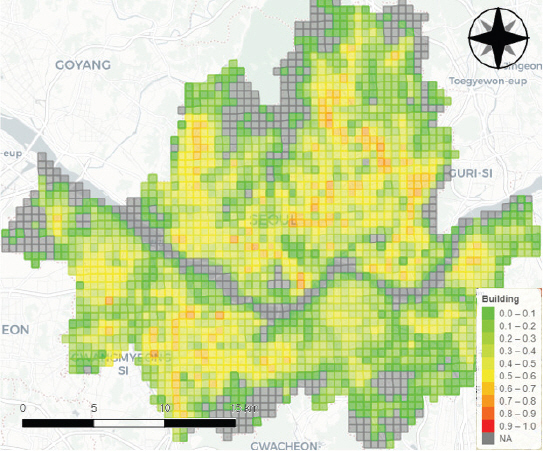
Ά╡φΊΗιΉιΧΈ│┤ΊΦΝΈητΊΠ╝ΉΩΡΉΕε ΉιεΆ│╡ΊΧαΈΛΦ Ά▒┤Ή╢ΧΈυ╝ΉΙα Ά▓σΉηΡΉηΡΈμΝΉΩΡ ΉηΖΈιξΈΡε ΊΗ╡Ά│ΕΆ░ΤΉζΑ ΈΠΕΈκεΈςΖΉμ╝ΉΗΝ ΉιΕΉηΡΉπΑΈΠΕΉβΑ Ά▒┤Ή╢ΧΈυ╝ΈΝΑΉηξΉζα ΈπνΉ╣φΉηΣΉΩΖΉζΕ ΊΗ╡ΊΧ┤ ΉΨ╗ΉΨ┤ΉπΕΈΜν. 1Ή░ρ ΈπνΉ╣φΉηΣΉΩΖΉΩΡΉΕι ΈΠΕΈκεΈςΖΉμ╝ΉΗΝ(ΉΔΒΉΕ╕Ήμ╝ΉΗΝ ΊΠυΊΧρ)Έξ╝ Ά╕░ΉνΑΉε╝Έκε ΈπνΉ╣φΊΧαΆ│ι ΉΩυΆ╕░ΉΕε ΈπνΉ╣φΈΡαΉπΑ ΉΧΛΉζΑ Ά▒┤Έυ╝ΉζΑ 2Ή░ρ ΈπνΉ╣φΉΩΡΉΕε ΈΠΕΈκεΈςΖΉμ╝ΉΗΝ(ΈΝΑΊΣεΉμ╝ΉΗΝ)Έκε ΈπνΉ╣φΊΧεΈΜν. 2Ή░ρ ΈπνΉ╣φΉηΣΉΩΖΉΩΡΉΕεΈΠΕ Ά▒┤Ή╢ΧΈυ╝ ΈΝΑΉηξΆ│╝ ΉΩ░Ά│ΕΈΡαΉπΑ ΉΧΛΉΧαΈΜνΈσ┤ Ή╡εΉλΖ ΈπνΉ╣φΉΩΡΉΕε ΉπΑΈ▓ΙΉιΧΈ│┤(PNU)Έκε ΈπνΉ╣φΉζΕ ΉΜεΈΠΕΊΧαΉΩυ Ά▓σΉηΡΉηΡΈμΝΈξ╝ ΉβΕΉΕ▒ΊΧεΈΜν. Ήζ┤ΈθυΊΧε ΉιεΉηΣ Ά│╝ΉιΧΉζΕ Ά▒░Ή╣ε Ά▒┤Ή╢ΧΈυ╝ΉΙα Ά▓σΉηΡΉηΡΈμΝΈΛΦ ΈΠΕΈκεΈςΖΉμ╝ΉΗΝ ΉιΕΉηΡΉπΑΈΠΕ ΈΝΑΈ╣Ε ΊΗ╡Ά│ΕΆ░ΤΉΩΡΉΕε Ή░ρΉζ┤Ά░Α Έ░εΉΔζΊΧι ΉΙα ΉηΙΆ╕░ ΈΧΝΈυ╕ΉΩΡ Ήζ┤Έξ╝ Έ│┤ΉιΧΊΧ┤ΉνΕ ΊΧΕΉγΦΆ░Α ΉηΙΈΜν.
3.2 ΊΨΚΉιΧΆ╡υΉΩφΈ│Ε ΉηΡΈμΝ ΉειΊαΧΉΩΡ ΈΦ░Έξ╕ Ά▒┤Ή╢ΧΈυ╝ΉΙα
Έ│╕ ΉΩ░Ά╡υΉΩΡΉΕεΈΛΦ Ά▓╜Ά╕░ΈΠΕ 31Ά░ε ΉΜεΆ╡░Έ│Ε Ά▒┤Ή╢ΧΈυ╝ΉΙαΈξ╝ ΉΓ░ΉιΧΊΧι ΈΧΝ ΈΠΕΈκεΈςΖΉμ╝ΉΗΝ ΉιΕΉηΡΉπΑΈΠΕΉβΑ Ά▒┤Ή╢ΧΈυ╝ΉΙα Ά▓σΉηΡΉηΡΈμΝΈξ╝ ΊΠυΉζ╕ΊΛ╕(point)Έκε Έ│ΑΊβαΊΧαΉΩυ ΉΜεΆ╡░Έ│Ε Ά▒┤Έυ╝ ΊΠυΊΧρΉΩυΈ╢ΑΈξ╝ ΊΝΡΉιΧΊΧαΉαΑΈΜν(
Fig. 3). Ά╖╕ Ά▓░Ά│╝ 2018ΈΖΕ 11ΉδΦ Ά╕░ΉνΑ Ά▓╜Ά╕░ΈΠΕ 31Ά░ε ΉΜεΆ╡░Έ│Ε Ά▒┤Ή╢ΧΈυ╝ ΉΙαΈΛΦ
Table 1Ά│╝ Ά░βΈΜν.
Fig.┬ι3
Determining Whether the Buildings are Included by Administrative District using Spatial Analysis Data
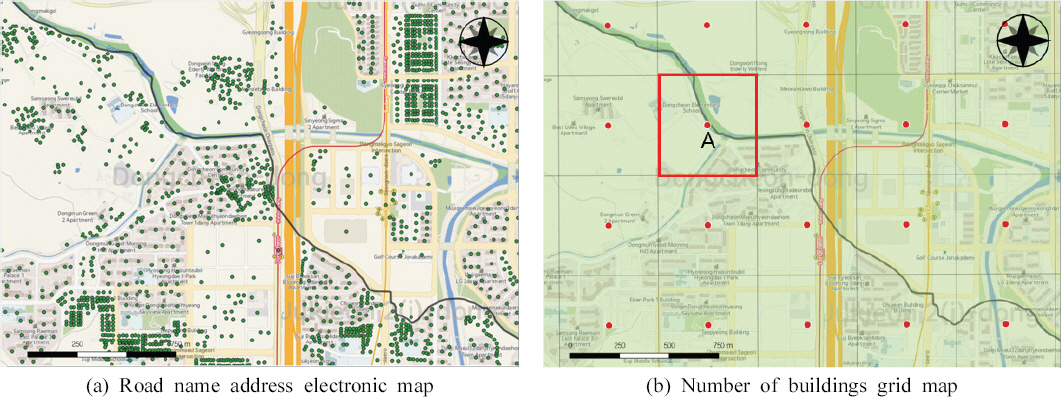
Table┬ι1
Number of Buildings by Administrative District in Gyeonggi-do
|
Administrative District |
Number of Buildings (Grid) |
Number of Buildings (Road name) |
Difference |
Difference Ratio |
Administrative District |
Number of Buildings (Grid) |
Number of Buildings (Road name) |
Difference |
Difference Ratio |
|
Suwon-si |
60,900 |
75,195 |
14,295 |
23% |
Uiwang-si |
6,537 |
9,245 |
2,708 |
41% |
|
Seongnam-si |
54,792 |
57,311 |
2,519 |
5% |
Hanam-si |
14,861 |
21,128 |
6,267 |
42% |
|
Uijeongbu-si |
23,214 |
34,319 |
11,105 |
48% |
Yongin-si |
63,933 |
98,145 |
34,212 |
54% |
|
Anyang-si |
22,567 |
29,192 |
6,625 |
29% |
Paju-si |
54,315 |
89,991 |
35,676 |
66% |
|
Bucheon-si |
35,211 |
45,846 |
10,635 |
30% |
Icheon-si |
37,154 |
78,742 |
41,588 |
112% |
|
Gwangmyeong-si |
13,180 |
16,293 |
3,113 |
24% |
Anseong-si |
41,184 |
65,435 |
24,251 |
59% |
|
Pyeongtaek-si |
61,704 |
102,182 |
40,478 |
66% |
Gimpo-si |
44,814 |
65,842 |
21,028 |
47% |
|
Dongducheon-si |
11,149 |
18,350 |
7,201 |
65% |
Hwaseong-si |
86,398 |
121,981 |
35,583 |
41% |
|
Ansan-si |
39,319 |
44,433 |
5,114 |
13% |
Gwangju-si |
42,767 |
55,443 |
12,676 |
30% |
|
Goyang-si |
56,196 |
78,698 |
22,502 |
40% |
Yangju-si |
27,521 |
61,954 |
34,433 |
125% |
|
Gwacheon-si |
2,598 |
5,147 |
2,549 |
98% |
Pocheon-si |
46,870 |
81,453 |
34,583 |
74% |
|
Guri-si |
9,951 |
13,136 |
3,185 |
32% |
Yeoju-si |
31,920 |
62,249 |
30,329 |
95% |
|
Namyangju-si |
49,895 |
68,821 |
18,926 |
38% |
Yeoncheon-gun |
14,966 |
27,780 |
12,814 |
86% |
|
Osan-si |
11,567 |
16,326 |
4,759 |
41% |
Gapyeong-gun |
22,562 |
50,544 |
27,982 |
124% |
|
Siheung-si |
26,467 |
38,554 |
12,087 |
46% |
Yangpyeong-gun |
40,517 |
70,076 |
29,559 |
73% |
|
Gunpo-si |
9,438 |
9,619 |
181 |
2% |
Έ╢ΕΉΕζΊΧ┤Έ│╕ Ά▓░Ά│╝ ΈςρΈΥι ΉΜεΆ╡░ΉΩΡΉΕε ΈΠΕΈκεΈςΖΉμ╝ΉΗΝ ΉιΕΉηΡΉπΑΈΠΕΈκε ΉΓ░ΉιΧΊΧε Ά▓░Ά│╝Ά░Α Ά▒┤Ή╢ΧΈυ╝ Ά▓σΉηΡΉηΡΈμΝΈξ╝ ΉΓυΉγσΊΧε Ά▓ΔΈ│┤ΈΜν Ά▒┤Ή╢ΧΈυ╝ΉΙαΆ░Α ΊΒυΆ▓Ν ΉΓ░ΉιΧΈΡαΉΩΙΈΜν. ΉΕ▒ΈΓρΉΜε, Ά╡░ΊΠυΉΜεΉζα Ά▓╜Ήγ░ Ά▓░Ά│╝Ά░ΤΉζα Έ╣ΕΉερ Ή░ρΉζ┤Ά░Α 5% Ήζ┤ΈΓ┤Ήζ┤ΉπΑΈπΝ, Ήζ┤Ή▓εΉΜε, ΉΨΣΉμ╝ΉΜε, Ά░ΑΊΠΚΆ╡░ΉζΑ 100% Ήζ┤ΉΔΒΉζα Ή░ρΉζ┤Έξ╝ Έ│┤ΉαΑΈΜν.
Fig. 3ΉΩΡΉΕεΉβΑ Ά░βΉζ┤ Ά▒┤Έυ╝Ήζα ΉΜεΆ╡░Έ│Ε ΉΗΝΉΗΞΉΩυΈ╢ΑΈξ╝ ΊΠυΉζ╕ΊΛ╕Έξ╝ Ά╕░ΉνΑΉε╝Έκε ΊΝΡΉιΧΊΧαΈσ┤ Ά▒┤Έυ╝Ήζ┤ Ά░ζΉ▓┤Έ│ΕΈκε Ά╡υΈ╢ΕΈΡε ΈΠΕΈκεΈςΖΉμ╝ΉΗΝ ΉιΕΉηΡΉπΑΈΠΕΈΛΦ ΊΨΚΉιΧΆ▓╜Ά│ΕΈξ╝ Ά╕░ΉνΑΉε╝Έκε ΉιΧΊβΧΊηΙ Έ╢ΕΊΧιΈΡεΈΜν. ΊΧαΉπΑΈπΝ, Ά▓σΉηΡΉηΡΈμΝΉζα Ά▓╜Ήγ░
Fig. 3Ήζα (b)ΉΩΡ ΊΣεΉΜεΈΡε A Ά▓σΉηΡΉβΑ Ά░βΉζ┤ ΈΜνΈξ╕ ΉπΑΉηΡΉ▓┤Ήζα Ά▒┤Ή╢ΧΈυ╝ΈΠΕ ΊΠυΉζ╕ΊΛ╕Ά░Α ΉΗΝΉΗΞΈΡε ΉπΑΉηΡΉ▓┤Ήζα Ά▒┤Έυ╝Έκε Ήζ╝Ά┤Ε ΊΝΡΉιΧΈΡεΈΜν. Έ│╕ ΉΩ░Ά╡υΉΩΡΉΕεΈΛΦ Ήζ┤ΈθυΊΧε ΊΛ╣ΉΕ▒ΈΥνΉζΕ Ά│ιΈινΊΧαΉΩυ ΈΣΡ Ά│╡Ά░ΕΈ╢ΕΉΕζΉηΡΈμΝΉζα Ή░ρΉζ┤Έξ╝ Έ│┤ΉιΧΊΧ┤Ήμ╝Ά╕░ ΉεΕΊΧ┤ ΈΜρΉΙεΉΕιΊαΧΊγΝΆ╖ΑΈ╢ΕΉΕζΉζΕ ΉιΒΉγσΊΧαΉαΑΈΜν(
Fig. 4,
Table 2).
Fig.┬ι4
Simple Linear Regression Analysis of the Number of Buildings
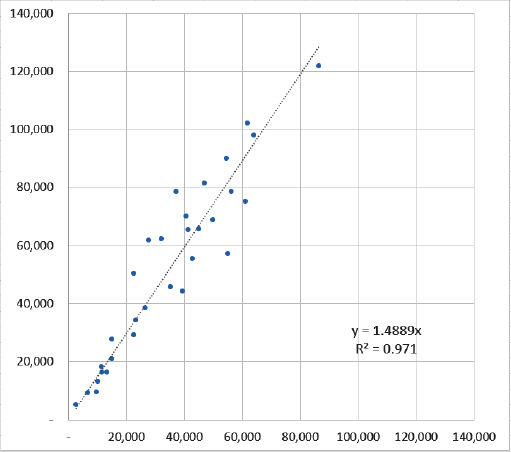
Table┬ι2
Simple Linear Regression Analysis Result
|
Regression Equation |
R2
|
F |
p |
RMSE |
|
y = 1.4889x
|
0.971 |
4.69336E-24 |
1.26793E-24 |
10,268 |
ΈΠΖΈο╜Έ│ΑΉΙαΈΛΦ Ά▒┤Ή╢ΧΈυ╝ΉΙα Ά▓σΉηΡΉηΡΈμΝ(xΉ╢Χ), ΉλΖΉΗΞΈ│ΑΉΙαΈΛΦ ΈΠΕΈκεΈςΖΉμ╝ΉΗΝ ΉιΕΉηΡΉπΑΈΠΕ(yΉ╢Χ), yΉιΙΊΟ╕ΉζΑ 0Ήε╝Έκε ΉΕνΉιΧΊΧε Ά▓░Ά│╝ Ά▓░ΉιΧΆ│ΕΉΙα(R
2)Ά░Α 0.971Ήζ╕ ΊγΝΆ╖ΑΉΜζΉζ┤ ΈπΝΈΥνΉΨ┤ΉκΝΈΜν. ΈπΝΈΥνΉΨ┤ΉπΕ ΊγΝΆ╖ΑΉΜζΉζΑ
Fig. 4ΉβΑ Ά░βΉζ┤ ΈΗΤΉζΑ ΉιΒΊΧσΈΠΕΈξ╝ Έ│┤ΉαΑΉε╝Έσ░, Ά╕░Ήκ┤ Ά▒┤Ή╢ΧΈυ╝ΉΙα Ά▓σΉηΡΉηΡΈμΝΉζα ΊΗ╡Ά│ΕΆ░ΤΉΩΡ ΊγΝΆ╖ΑΉΜζΉζΕ ΉιΒΉγσΊΨΙΉζΕ ΈΧΝ ΈΠΕΈκεΈςΖΉμ╝ΉΗΝ ΉιΕΉηΡΉπΑΈΠΕΉζα ΊΗ╡Ά│ΕΆ░ΤΆ│╝ Ή░ρΉζ┤Ά░Α Ά░ΡΉΗΝΊΨΙΉζΝΉζΕ ΊβΧΉζ╕ΊΧαΉαΑΈΜν. Ά▒┤Ή╢ΧΈυ╝ΉΙαΈΛΦ ΉΕ╕Έ╢ΑΉπΑΊΣεΉζα ΊΛ╣ΉΕ▒ΉΔΒ ΉΩ░ΈΠΕΈ│Ε ΊΗ╡Ά│ΕΈθΚΉζα Έ│ΑΊβΦΆ░Α ΊΒυΉπΑ ΉΧΛΆ╕░ ΈΧΝΈυ╕ΉΩΡ Ά▓╜Ά╕░ΈΠΕ ΉΜεΆ╡░ΉζΕ ΈΝΑΉΔΒΉε╝Έκε ΈΠΕΈκεΈςΖΉμ╝ΉΗΝ ΉιΕΉηΡΉπΑΈΠΕ ΈΝΑΉΜι Ά▒┤Ή╢ΧΈυ╝ΉΙα Ά▓σΉηΡΉηΡΈμΝΈξ╝ ΉΓυΉγσΊΧαΆ│ιΉηΡ ΊΧεΈΜνΈσ┤ ΊγΝΆ╖ΑΉΜζΉζΕ ΉΓυΉγσΊΧε ΊΗ╡Ά│ΕΆ░Τ Έ│┤ΉιΧΉζ┤ Ά░ΑΈΛξΊΧαΈΜν.
3.3 ΊΨΚΉιΧΆ╡υΉΩφΈ│Ε Ή╣ρΉΙαΊΦ╝ΊΧ┤ ΉαΒΊΨξΈ▓ΦΉεΕ ΈΓ┤ Ά▒┤Ή╢ΧΈυ╝ΉΙα
Έ│╕ ΉΩ░Ά╡υΉΩΡΉΕεΈΛΦ Ά▓╜Ά╕░ΈΠΕ ΉΜεΆ╡░Έ│Ε Ή╣ρΉΙαΊΦ╝ΊΧ┤ ΉαΒΊΨξΈ▓ΦΉεΕ ΈΓ┤ΉΩΡ ΉεΕΉ╣αΊΧε Ά▒┤Ή╢ΧΈυ╝ΉζΕ ΉΕιΈ│ΕΊΧαΆ╕░ ΉεΕΊΧ┤ ΊβαΆ▓╜Έ╢ΑΉβΑ ΊΨΚΉιΧΉΧΙΉιΕΈ╢ΑΉζα ΉΔΒΉεΕΈ╣ΙΈΠΕ ΊΧαΉ▓εΉηυΊΧ┤ ΊβΞΉΙαΉεΕΊΩαΉπΑΈΠΕΈξ╝ ΉΓυΉγσΊΧαΉαΑΈΜν. Ά▒┤Ή╢ΧΈυ╝Ήζ┤ Ή╣ρΉΙαΊΦ╝ΊΧ┤ ΉαΒΊΨξΈ▓ΦΉεΕ ΈΓ┤ΉΩΡ ΈΥνΉΨ┤ΉανΈΛΦ ΊΝΡΉιΧΉΩυΈ╢ΑΈΛΦ ΊΨΚΉιΧΆ╡υΉΩφΈ│Ε ΊΝΡΉιΧΈ▓ΧΆ│╝ ΈπΙΉ░υΆ░ΑΉπΑΈκε ΊΠυΉζ╕ΊΛ╕Ήζα ΊΠυΊΧρΉΩυΈ╢ΑΈξ╝ Ά╕░ΉνΑΉε╝Έκε ΊΝΡΉιΧΊΧαΉαΑΈΜν.
Fig. 5ΈΛΦ ΉΙαΈΠΕΆ╢Ν ΈΓ┤ΉΩΡ ΉεΕΉ╣αΊΧε Ά╡φΆ░ΑΊΧαΉ▓ε, ΉπΑΈ░σΊΧαΉ▓ε, ΉΗΝΊΧαΉ▓ε ΊβΞΉΙαΉεΕΊΩαΉπΑΈΠΕΉζα Έ╢ΕΊΠυΈξ╝ ΈΓαΊΔΑΈΓ╕ Ά▓ΔΉζ┤Έσ░,
Table 3ΉζΑ Ά▓╜Ά╕░ΈΠΕ 31Ά░ε ΉΜεΆ╡░Έ│Ε ΊβΞΉΙαΉεΕΊΩαΉπΑΈΠΕΉβΑ ΉνΣΉ▓σΈΡε Ά▒┤Ή╢ΧΈυ╝ΉΙαΈξ╝ ΈΓαΊΔΑΈΓ╕ Ά▓ΔΉζ┤ΈΜν.
Fig.┬ι5
Metropolitan Area Flood Risk Map Distribution
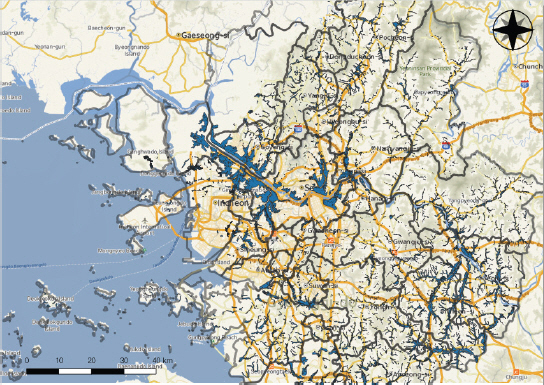
Table┬ι3
Number of Buildings Within the Impact Range of Flood Damage by Administrative District in Gyeonggi-do
|
Administrative District |
Number of Buildings (Grid) |
Number of Buildings (Road name) |
Difference |
Difference Ratio |
Administrative District |
Number of Buildings (Grid) |
Number of Buildings (Road name) |
Difference |
Difference Ratio |
|
Suwon-si |
1,814 |
2,772 |
958 |
53% |
Uiwang-si |
133 |
240 |
107 |
80% |
|
Seongnam-si |
155 |
228 |
73 |
47% |
Hanam-si |
1,332 |
1,569 |
237 |
18% |
|
Uijeongbu-si |
702 |
1,922 |
1,220 |
174% |
Yongin-si |
2,904 |
6,610 |
3,706 |
128% |
|
Anyang-si |
1,208 |
911 |
-297 |
-25% |
Paju-si |
1,177 |
1,749 |
572 |
49% |
|
Bucheon-si |
557 |
275 |
-282 |
-51% |
Icheon-si |
4,717 |
6,607 |
1,890 |
40% |
|
Gwangmyeong-si |
5,874 |
5,570 |
-304 |
-5% |
Anseong-si |
5,328 |
7,557 |
2,229 |
42% |
|
Pyeongtaek-si |
3,890 |
4,174 |
284 |
7% |
Gimpo-si |
5,506 |
7,758 |
2,252 |
41% |
|
Dongducheon-si |
775 |
1,894 |
1,119 |
144% |
Hwaseong-si |
3,964 |
3,390 |
-574 |
-14% |
|
Ansan-si |
338 |
601 |
263 |
78% |
Gwangju-si |
2,637 |
3,671 |
1,034 |
39% |
|
Goyang-si |
10,575 |
14,928 |
4,353 |
41% |
Yangju-si |
1,576 |
4,141 |
2,565 |
163% |
|
Gwacheon-si |
144 |
567 |
423 |
294% |
Pocheon-si |
4,847 |
6,218 |
1,371 |
28% |
|
Guri-si |
1,927 |
2,598 |
671 |
35% |
Yeoju-si |
3,823 |
5,098 |
1,275 |
33% |
|
Namyangju-si |
3,473 |
6,307 |
2,834 |
82% |
Yeoncheon-gun |
167 |
99 |
-68 |
-41% |
|
Osan-si |
209 |
191 |
-18 |
-9% |
Gapyeong-gun |
2,112 |
6,839 |
4,727 |
224% |
|
Siheung-si |
246 |
609 |
363 |
148% |
Yangpyeong-gun |
3,493 |
7,309 |
3,816 |
109% |
|
Gunpo-si |
546 |
451 |
-95 |
-17% |
ΉΧηΉΩΡΉΕε Ά▓╜Ά╕░ΈΠΕ 31Ά░ε ΉΜεΆ╡░Έ│Ε Ά▒┤Ή╢ΧΈυ╝ΉΙαΈξ╝ ΉΓ░ΉιΧΊΨΙΉζΕ ΈΧΝΉΩΡΈΛΦ ΈςρΈΥι ΉΜεΆ╡░ΉΩΡΉΕε ΈΠΕΈκεΈςΖΉμ╝ΉΗΝ ΉιΕΉηΡΉπΑΈΠΕΉζα ΊΗ╡Ά│ΕΆ░ΤΉζ┤ Ά▒┤Ή╢ΧΈυ╝ Ά▓σΉηΡΉηΡΈμΝΈ│┤ΈΜν ΊΒυΆ▓Ν ΉΓ░ΉιΧΈΡαΉΩΙΈΜν. ΊΧαΉπΑΈπΝ ΊβΞΉΙαΉεΕΊΩαΉπΑΈΠΕΉβΑ ΉνΣΉ▓σΈΡε Ά▒┤Ή╢ΧΈυ╝ΈπΝ Ή╢ΦΉ╢εΊΨΙΉζΕ Ά▓╜Ήγ░ΉΩΡΈΛΦ ΈΜνΈξ╕ Ά▓░Ά│╝Ά░Α ΈΠΕΉ╢εΈΡαΉΩΙΈΛΦΈΞ░, Έ╢ΑΉ▓εΉΜε, ΉΩ░Ή▓εΆ╡░, ΉΧΙΉΨΣΉΜε ΈΥ▒ 7Ά░εΉζα ΉΜεΆ╡░ΉΩΡΉΕι ΉανΊηΙΈιν Ά▒┤Ή╢ΧΈυ╝ Ά▓σΉηΡΉηΡΈμΝΉζα ΊΗ╡Ά│ΕΆ░ΤΉζ┤ ΈΠΕΈκεΈςΖΉμ╝ΉΗΝ ΉιΕΉηΡΉπΑΈΠΕΈ│┤ΈΜν ΊΒυΆ▓Ν ΉΓ░ΉιΧΈΡαΉΩΙΈΜν. Ήζ┤ΈθυΊΧε ΊαΕΉΔΒΉζ┤ Έ░εΉΔζΊΧε Ήζ┤ΉειΈΛΦ ΊβΞΉΙαΉεΕΊΩαΉπΑΈΠΕΉβΑ ΉνΣΉ▓σ ΈΡε ΊΠυΉζ╕ΊΛ╕ΈπΝ Ή╢ΦΉ╢εΊΧε Ά▓░Ά│╝ ΈΝΑΉΔΒ ΉπΑΉηΡΉ▓┤ΉΩΡΉΕε ΉΗΝΆ╖εΈςρ ΊΠυΉζ╕ΊΛ╕ΈπΝ Ή╢ΦΉ╢εΈΡαΉΩΙΉζΕ Ά▓╜Ήγ░ Ά▓σΉηΡΈ│Ε ΊΠυΉζ╕ΊΛ╕(ΉνΣΉΜυΉιΡ)Ήζα ΉνΣΉ▓σΉΩυΈ╢ΑΉΩΡ ΈΦ░Έζ╝ ΉΓ░ΉιΧΈΡαΈΛΦ ΊΗ╡Ά│ΕΆ░ΤΉζα Ή░ρΉζ┤Ά░Α ΊΒυΆ▓Ν Έ░εΉΔζΊΧαΆ╕░ ΈΧΝΈυ╕Ήζ┤ΈΜν. Ή╣ρΉΙαΊΦ╝ΊΧ┤ ΉαΒΊΨξΈ▓ΦΉεΕ ΈΓ┤ Ά▒┤Ή╢ΧΈυ╝ΉΙα ΊΗ╡Ά│ΕΆ░ΤΉζα Ή░ρΉζ┤Έξ╝ Έ│┤ΉιΧΊΧ┤Ήμ╝Ά╕░ ΉεΕΊΧ┤ ΈΜρΉΙεΉΕιΊαΧΊγΝΆ╖ΑΈ╢ΕΉΕζΉζΕ ΉιΒΉγσΊΧε Ά▓░Ά│╝ΈΛΦ
Fig. 6,
Table 4ΉβΑ Ά░βΈΜν.
Fig.┬ι6
Simple Linear Regression Analysis for the Number of Buildings Within the Impact Range of Flood Damage

Table┬ι4
Simple Linear Regression Analysis Result (2)
|
Regression Equation |
R2
|
F |
p |
RMSE |
|
y=1.4037x
|
0.9337 |
7.80941E-19 |
3.13447E-19 |
1,268 |
Έρ╝ΉιΑ ΉπΕΊΨΚΊΨΙΈΞα ΉΕιΊαΧΊγΝΆ╖ΑΈ╢ΕΉΕζΆ│╝ ΈΠβΉζ╝ΊΧε Ήκ░Ά▒┤ ΊΧαΉΩΡΉΕε Έ╢ΕΉΕζΉζΕ ΉπΕΊΨΚΊΧε Ά▓░Ά│╝ Ά▓░ΉιΧΆ│ΕΉΙα(R
2)Ά░Α 0.9337Ήζ╕ ΉΕιΊαΧΊγΝΆ╖ΑΉΜζΉζ┤ ΈπΝΈΥνΉΨ┤ΉκΝΈΜν. 31Ά░ε ΉΜεΆ╡░ ΉνΣ Ά│ιΉΨΣΉΜεΉζα Ά▓╜Ήγ░ Ά▒┤Ή╢ΧΈυ╝ΉΙα ΊΗ╡Ά│ΕΆ░ΤΉζ┤ ΊΒυΆ▓Ν ΉΓ░ΉιΧΈΡαΉΨ┤ ΈΜνΈξ╕ ΉΜεΆ╡░ΈΥνΉζα Έ╢ΕΊΠυΉβΑ Ή░ρΉζ┤Έξ╝ Έ│┤Ήζ┤ΉπΑΈπΝ,
Fig. 6ΉΩΡΉΕε ΊβΧΉζ╕ΊΧι ΉΙα ΉηΙΈΥψΉζ┤ ΊγΝΆ╖ΑΉΜζΉζα ΉιΒΊΧσΈΠΕΉΩΡ ΊΒυΆ▓Ν ΉαΒΊΨξΉζΕ Ήμ╝ΉπΕ ΉΧΛΉΧαΈΜν. Ά▓╜Ά╕░ΈΠΕ ΉΜεΆ╡░ΉΩΡΉΕε Ά▓σΉηΡΉηΡΈμΝΈκε Ή╣ρΉΙαΊΦ╝ΊΧ┤ ΉαΒΊΨξΈ▓ΦΉεΕ ΈΓ┤ Ά▒┤Ή╢ΧΈυ╝ΉΙαΈξ╝ ΉΓ░ΉιΧΊΧι ΈΧΝΉΩΡΈΠΕ ΊΧ┤ΈΜ╣ ΊγΝΆ╖ΑΉΜζΉζΕ ΊΗ╡ΊΧ┤ ΊΗ╡Ά│ΕΆ░ΤΉζΕ Έ│┤ΉιΧΊΧι ΉΙα ΉηΙΈΜν.
3.4 ΉΕ╕Έ╢ΑΉπΑΊΣε(Ά▒┤Ή╢ΧΈυ╝ΉΙα) ΉπΑΉΙα Έ╣ΕΆ╡ΡΈ╢ΕΉΕζ
ΊβΞΉΙαΉεΕΊΩαΈΠΕ ΊΠΚΆ░ΑΉΩΡΉΕε ΉΕ╕Έ╢ΑΉπΑΊΣεΉΩΡ ΈΝΑΊΧε ΉπΑΉΙαΈξ╝ ΉΓ░ΉιΧΊΧαΈΛΦ Έ░σΈ▓ΧΉε╝ΈκεΈΛΦ ΊΣεΉνΑΊβΦ, Ά╡υΆ░ΕΈ│Ε ΉιΡΉΙαΊβΦ ΈΥ▒ ΈΜνΉΨΣΊΧε Έ░σΈ▓ΧΈκιΉζ┤ ΉηΙΈΜν. Έ│╕ ΉΩ░Ά╡υΉΩΡΉΕεΈΛΦ ΉΕ╕Έ╢ΑΉπΑΊΣε(Ά▒┤Ή╢ΧΈυ╝ΉΙα) ΉπΑΉΙαΉζα ΉιΧΆ╖εΉΕ▒ΉζΕ Ά│ιΈινΊΧαΉΩυ Eq. (1)Ά│╝ Ά░βΉζ┤ ΈΠΕΈκεΈςΖΉμ╝ΉΗΝ ΉιΕΉηΡΉπΑΈΠΕΉβΑ Ά▓σΉηΡΉηΡΈμΝΉΩΡΉΕε ΉπΣΆ│ΕΊΧε ΉπΑΉηΡΉ▓┤Έ│Ε Ά▒┤Ή╢ΧΈυ╝ΉΙα ΊΗ╡Ά│ΕΆ░ΤΉζΕ root Έ│ΑΊβα ΊδΕ min-max ΊΣεΉνΑΊβΦΈξ╝ ΉιΒΉγσΊΧαΉαΑΈΜν.
min-max ΊΣεΉνΑΊβΦΈξ╝ ΉιΒΉγσΊΧαΉΩυ ΉΓ░ΉιΧΊΧε ΉπΑΉΙαΈΛΦ 0έΙ╝1 ΉΓυΉζ┤Ήζα Ά░ΤΉζΕ Ά░ΑΉπΑΈσ░, ΉΓ░ΉιΧΈΡε ΉπΑΉΙαΈξ╝ Ά╕░ΉνΑΉε╝Έκε ΉπΑΉηΡΉ▓┤Έ│Ε ΊβΞΉΙαΉεΕΊΩαΉΩΡ ΈΖ╕Ή╢εΈΡε Ά▒┤Ή╢ΧΈυ╝ΉΙαΈξ╝ Έ╣ΕΆ╡ΡΊΧι ΉΙα ΉηΙΈΜν.
Fig. 7ΉζΑ ΉπΑΉηΡΉ▓┤Έ│Ε ΈΠΕΈκεΈςΖΉμ╝ΉΗΝ ΉιΕΉηΡΉπΑΈΠΕΉβΑ Ά▒┤Ή╢ΧΈυ╝ΉΙα Ά▓σΉηΡΉηΡΈμΝ(Έ│┤ΉιΧΆ│ΕΉΙα ΉιΒΉγσ)Ήζα Ά▒┤Ή╢ΧΈυ╝ΉΙαΈξ╝ ΊΣεΉνΑΊβΦΊΧαΉΩυ ΊΗ╡Ά│ΕΉπΑΈΠΕΈκε ΈΓαΊΔΑΈΓ╕ Ά▓ΔΉζ┤ΈΜν. ΈαΡΊΧε ΈΠβΉζ╝ΊΧε Έ░σΈ▓ΧΉε╝Έκε Ή╣ρΉΙαΊΦ╝ΊΧ┤ ΉαΒΊΨξΈ▓ΦΉεΕ ΈΓ┤Ήζα Ά▒┤Ή╢ΧΈυ╝ΉΙαΈξ╝ ΊΣεΉνΑΊβΦΊΧαΉΩυ ΉηΣΉΕ▒ΊΧε ΊΗ╡Ά│ΕΉπΑΈΠΕΈΛΦ
Fig. 8Ήζ┤ΈΜν.
Fig.┬ι7
Comparison of Standardization Index for the Number of Buildings
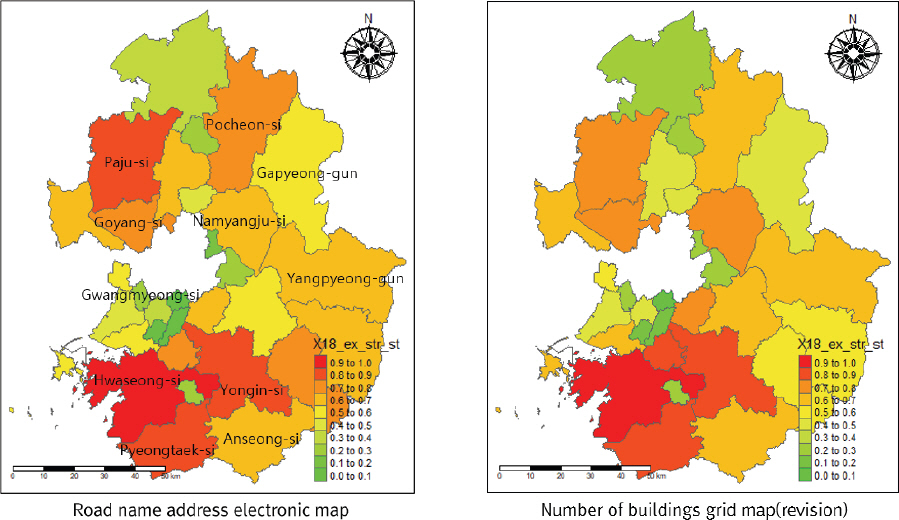
Fig.┬ι8
Comparison of Standardization Index for the Number of Buildings using Overlapped Flood Hazard Map
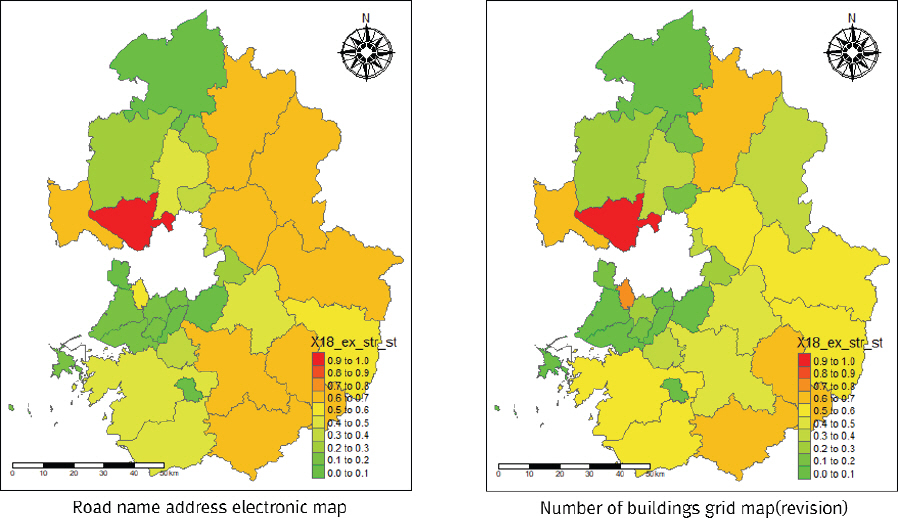
ΈΣΡ Ά│╡Ά░ΕΈ╢ΕΉΕζΉηΡΈμΝΉζα Ά▒┤Ή╢ΧΈυ╝ΉΙαΉΩΡ ΈΝΑΊΧε ΊΣεΉνΑΊβΦ ΉπΑΉΙαΈξ╝ ΉΓ░ΉιΧΊΧε Ά▓░Ά│╝
Fig. 7ΉΩΡΉΕεΈΛΦ ΊΝΝΉμ╝ΉΜε, Ά░ΑΊΠΚΆ╡░, ΈΓρΉΨΣΉμ╝ΉΜε ΈΥ▒ Ήζ╝Έ╢Α ΉΜεΆ╡░ΉΩΡΉΕε Ή░ρΉζ┤Έξ╝ Έ│┤ΉαΑΉε╝Έσ░,
Fig. 8ΉΩΡΉΕεΈΛΦ ΉγσΉζ╕ΉΜε, ΉΨΣΊΠΚΆ╡░, ΈΓρΉΨΣΉμ╝ΉΜε ΈΥ▒ΉΩΡΉΕε Ή░ρΉζ┤Ά░Α Έ░εΉΔζΊΧαΉαΑΈΜν. ΊΧαΉπΑΈπΝ Έυ┤ΉΩΘΈ│┤ΈΜν ΈΣΡΈΥεΈθυΉπΑΈΛΦ Ή░ρΉζ┤ΈΛΦ
Fig. 7Ά│╝
Fig. 8 ΉΓυΉζ┤Ήζα Έ╣ΕΆ╡ΡΉΩΡΉΕε Έ░εΉΔζΊΧαΈΛΦΈΞ░, ΈΜρΉΙεΊηΙ ΈΝΑΉΔΒ ΉΜεΆ╡░Έ│Ε Ή┤ζ Ά▒┤Ή╢ΧΈυ╝ΉΙαΈξ╝ ΈΓαΊΔΑΈΓ╕
Fig. 7Ά│╝ΈΛΦ ΈΜυΈου
Fig. 8ΉΩΡΉΕεΈΛΦ ΊβΞΉΙαΉεΕΊΩαΉπΑΈΠΕΉβΑ ΉνΣΉ▓σΈΡε Ά▒┤Ή╢ΧΈυ╝ ΉΙαΈπΝ ΊΗ╡Ά│ΕΆ░ΤΉΩΡ Έ░αΉαΒΊΨΙΆ╕░ ΈΧΝΈυ╕ΉΩΡ ΊβΞΉΙαΉεΕΊΩαΉζ┤ ΈΗΤΉζΑ ΉΜεΆ╡░Ήζα ΊΣεΉνΑΊβΦ ΉπΑΉΙαΆ░Α ΊΒυΆ▓Ν ΉΓ░ΉιΧΈΡεΈΜν. ΉοΚ
Fig. 7ΉΩΡΉΕεΈΛΦ Ά▓╜Ά╕░ΈΠΕ ΉΜεΆ╡░ ΉνΣ Ά▒┤Ή╢ΧΈυ╝ΉΙαΆ░Α ΈπΟΉζΑ ΊβΦΉΕ▒ΉΜε, ΉγσΉζ╕ΉΜε, ΊΠΚΊΔζΉΜε ΈΥ▒ΉΩΡΉΕε ΉπΑΉΙαΆ░Α ΊΒυΆ▓Ν ΉΓ░ΉιΧΈΡε Έ░αΈσ┤,
Fig. 8ΉΩΡΉΕεΈΛΦ ΊβΞΉΙαΉεΕΊΩαΉΩΡ ΈΖ╕Ή╢εΈΡε Ά▒┤Έυ╝Ήζ┤ ΈπΟΉζΑ Ά│ιΉΨΣΉΜε, ΊΠυΉ▓εΉΜε, ΉΧΙΉΕ▒ΉΜε ΈΥ▒Ήζα ΉπΑΉηΡΉ▓┤ΉΩΡΉΕε ΉπΑΉΙαΆ░Α ΊΒυΆ▓Ν ΉΓ░ΉιΧΈΡαΉΩΙΈΜν. Έ│╕ ΉΩ░Ά╡υΉΩΡΉΕε ΉΕεΈκε ΈΜνΈξ╕ ΉειΊαΧΉζα ΊΗ╡Ά│ΕΉηΡΈμΝΈξ╝ ΉΓυΉγσΊΧαΉΩυ ΈΠΕΉ╢εΈΡε Ά▓░Ά│╝Έξ╝ Έ╣ΕΆ╡ΡΊΨΙΉζΕ ΈΧΝ ΊβΞΉΙαΉεΕΊΩαΉπΑΈΠΕΉβΑ ΉνΣΉ▓σΈΡε Ά▒┤Ή╢ΧΈυ╝ΉΙαΈκε ΉπΣΆ│ΕΊΧε ΊΗ╡Ά│ΕΆ░ΤΉζ┤ ΊβΞΉΙαΉεΕΊΩαΈΠΕΈξ╝ ΊΠΚΆ░ΑΊΧαΈΛΦΈΞ░ ΈΞΦ ΊΔΑΈΜ╣ΉΕ▒Ήζ┤ ΈΗΤΉζΝΉζΕ ΊβΧΉζ╕ΊΧι ΉΙα ΉηΙΉΩΙΈΜν.
4. Ά▓░ Έκι
ΉιΕ ΉπΑΆ╡υΉιΒ Ά╕░ΊδΕΈ│ΑΊβΦΉζα ΉαΒΊΨξΉε╝Έκε 2020ΈΖΕΉΩΡΈΠΕ ΉπΣΉνΣΊα╕Ήγ░ Έ░Π ΊΔεΊΤΞ ΊΦ╝ΊΧ┤Ά░Α ΊΒυΆ▓Ν Έ░εΉΔζΊΧρΉΩΡ ΈΦ░Έζ╝ ΉνΣΉΧβΉιΧΈ╢Α Έ░Π ΉπΑΉηΡΉ▓┤ΉΩΡΉΕεΈΛΦ ΊβΞΉΙαΉεΕΊΩαΉΩΡ ΈΝΑΊΧε Ά┤ΑΉΜυΉζ┤ ΈΗΤΉΧΕΉπΑΆ│ι ΉηΙΈΜν. ΉιΧΈ╢ΑΉΩΡΉΕεΈΛΦ ΉπΑΉηΡΉ▓┤Έ│Ε ΉηυΈΓεΉΩΡ ΈΝΑΊΧε ΉεΕΊΩαΈΠΕΈξ╝ ΊΠΚΆ░ΑΊΧαΆ╕░ ΉεΕΊΧ┤ ΉπΑΉΩφΉΧΙΉιΕΉπΑΉΙα, ΉπΑΉΩφΉΧΙΉιΕΈΠΕ ΊΠΚΆ░Α ΈΥ▒ΉζΕ ΉΜεΊΨΚΊΧαΆ│ι ΉηΙΉπΑΈπΝ, ΊβΞΉΙαΉΩΡ ΈΝΑΊΧε ΉεΕΊΩαΈΠΕΈξ╝ Έ│┤ΉΩυΉμ╝ΈΛΦ ΈΞ░ΉΩΡΈΛΦ ΉΩυΈθυ Ά░ΑΉπΑ Έ│┤ΉβΕΉιΡΉζΕ Ά░ΑΉπΑΆ│ι ΉηΙΈΜν. Έ│╕ ΉΩ░Ά╡υΉΩΡΉΕεΈΛΦ Ά▓σΉηΡΈΜρΉεΕ Ά│╡Ά░ΕΈ╢ΕΉΕζΉηΡΈμΝΉβΑ ΊβΞΉΙαΉεΕΊΩαΉπΑΈΠΕΈξ╝ ΊβεΉγσΊΧε Έ╢ΕΉΕζΉΩΡΉΕε ΈΜνΉζΝΆ│╝ Ά░βΉζΑ ΉΜεΉΓυΉιΡΉζΕ ΉΨ╗ΉζΕ ΉΙα ΉηΙΉΩΙΈΜν.
Ή▓τΉπ╕ΈΛΦ ΊβΞΉΙαΉεΕΊΩαΈΠΕ ΊΠΚΆ░ΑΉΩΡΉΕε Ά▓σΉηΡΈΜρΉεΕ Ά│╡Ά░ΕΈ╢ΕΉΕζΉηΡΈμΝΉζα ΉειΉγσΊΧρΉζ┤ΈΜν. ΉπΑΉηΡΉ▓┤Έ│Ε Ά▒┤Ή╢ΧΈυ╝ΉΙα ΉΓ░ΉιΧΉΩΡΉΕεΈΛΦ ΈΠΕΈκεΈςΖΉμ╝ΉΗΝ ΉιΕΉηΡΉπΑΈΠΕΈξ╝ ΉΓυΉγσΊΧαΈΛΦ Ά▓ΔΉζ┤ Ά▒┤Ή╢ΧΈυ╝ΉΙα Ά▓σΉηΡΉηΡΈμΝΈ│┤ΈΜν ΉιΧΊβΧΊΧε ΊΗ╡Ά│ΕΆ░Τ ΉΓ░ΉιΧΉζ┤ Ά░ΑΈΛξΊΧαΉπΑΈπΝ ΉηΡΈμΝ Ά░ΑΆ│╡ Έ░Π Ά▓░Ά│╝Ά░Τ ΉΓ░ΉιΧΉΩΡ ΉΨ┤ΈινΉδΑΉζ┤ ΊΒυΈΜν. ΉαΙΈξ╝ ΈΥνΉΨ┤ Έ│╕ ΉΩ░Ά╡υΉΩΡΉΕε ΉΓυΉγσΊΧε Ά▓╜Ά╕░ΈΠΕ ΈΠΕΈκεΈςΖΉμ╝ΉΗΝ ΉιΕΉηΡΉπΑΈΠΕΈΛΦ 160ΈπΝΆ░ε Ήζ┤ΉΔΒΉζα Ά▒┤Έυ╝ ΊΠ┤ΈουΆ│νΉζΕ Ά░ΑΉπΑΆ│ι ΉηΙΈΛΦΈΞ░ ΈπΝΉΧ╜ ΉΩ░Ά╡υΈ▓ΦΉεΕΈξ╝ ΉΕεΉγ╕ΊΛ╣Έ│ΕΉΜεΈξ╝ ΊΠυΊΧρΊΧε ΉιΕΆ╡φ ΉπΑΉηΡΉ▓┤Έκε ΊβΧΈΝΑΊΧεΈΜνΈσ┤ ΉηΣΉΩΖ ΈΓεΉζ┤ΈΠΕΈΛΦ ΊΒυΆ▓Ν ΉΔΒΉΛ╣ΊΧεΈΜν. Έ░αΈσ┤ Ά▒┤Ή╢ΧΈυ╝ΉΙα Ά▓σΉηΡΉηΡΈμΝΈΛΦ ΈΠΕΈκεΈςΖΉμ╝ΉΗΝ ΉιΕΉηΡΉπΑΈΠΕ ΈΝΑΈ╣Ε ΉηΡΈμΝΆ░ΑΆ│╡ Έ░Π ΊΗ╡Ά│ΕΆ░Τ ΉΓ░ΉιΧΉζ┤ Ά░ΕΊΟ╕ΊΧαΆ│ι ΊΗ╡Ά│ΕΉπΑΈΠΕΈξ╝ ΉηΣΉΕ▒ΊΧαΉΩυ ΉζαΉΓυΆ▓░ΉιΧΉζΕ ΉπΑΉδΡΊΧι ΉΙα ΉηΙΆ╕░ ΈΧΝΈυ╕ΉΩΡ ΊβΞΉΙαΉεΕΊΩαΈΠΕ ΊΠΚΆ░ΑΉΩΡ ΉιΒΊΧσΊΧαΈΜν.
ΈΣαΉπ╕ΈΛΦ Ή╣ρΉΙαΊΦ╝ΊΧ┤ ΉαΒΊΨξΈ▓ΦΉεΕ ΈΓ┤ ΊΗ╡Ά│ΕΆ░Τ ΉΓυΉγσΉζα ΊΔΑΈΜ╣ΉΕ▒Ήζ┤ΈΜν. Ά╕░Ήκ┤ ΊβΞΉΙαΉεΕΊΩαΈΠΕ ΊΠΚΆ░ΑΉΩΡΉΕε ΉΓυΉγσΊΧαΈΛΦ ΊΗ╡Ά│ΕΉηΡΈμΝΈΛΦ ΊΗ╡Ά│ΕΉΩ░Έ│┤, ΉηυΊΧ┤ΉΩ░Έ│┤ ΈΥ▒ΉΩΡΉΕε ΉΨ╗ΉζΑ ΊΗ╡Ά│ΕΆ░ΤΉζΕ Ά░ΑΆ│╡ ΉΩΗΉζ┤ Ά╖╕ΈΝΑΈκε ΉΓυΉγσΊΧαΆ╕░ ΈΧΝΈυ╕ΉΩΡ ΊβΞΉΙαΊΦ╝ΊΧ┤ΉΩΡ ΈΝΑΊΧε ΉΩ░Ά┤ΑΉΕ▒ΉΩΡ ΉζαΈυ╕Ήζ┤ ΉιεΆ╕░ΈΡαΉΨ┤ ΉβΦΈΜν. ΊΧαΉπΑΈπΝ Έ│╕ ΉΩ░Ά╡υΉΩΡΉΕεΉ▓αΈθ╝ ΊβΞΉΙαΉεΕΊΩαΉπΑΈΠΕΉβΑ Ά▓σΉηΡΉηΡΈμΝΈξ╝ ΉΓυΉγσΊΧαΉΩυ ΊΗ╡Ά│ΕΆ░ΤΉζΕ ΉΕιΈ│ΕΊΧαΈσ┤ ΉΩ░ΈΠΕΈ│ΕΈκε ΊβΞΉΙαΉεΕΊΩαΉΩΡ Ή╖ρΉΧ╜ΊΧε ΉπΑΉηΡΉ▓┤Έξ╝ ΊΠΚΆ░ΑΊΧαΈΛΦ ΈΞ░ ΊΔΑΈΜ╣ΊΧε ΉπΑΊΣεΆ░Α ΈΡι ΉΙα ΉηΙΈΜν.
ΉΖΜΉπ╕ΈΛΦ ΈΠΕΈκεΈςΖΉμ╝ΉΗΝ ΉιΕΉηΡΉπΑΈΠΕΉβΑ Ά▒┤Ή╢ΧΈυ╝ΉΙα Ά▓σΉηΡΉπΑΈΠΕΉζα ΊΗ╡Ά│ΕΆ░Τ Έ╣ΕΆ╡ΡΈ╢ΕΉΕζΉζΕ ΊΗ╡ΊΧ┤ ΉανΉ░ρΈξ╝ Έ│┤ΉιΧΊΧι ΊγΝΆ╖ΑΉΜζΉζΕ Έ░εΆ▓υΊΧε ΉιΡΉζ┤ΈΜν. Ά▒┤Ή╢ΧΈυ╝ΉΙα Ά▓σΉηΡΉπΑΈΠΕΈΛΦ ΈΠΕΈκεΈςΖΉμ╝ΉΗΝ ΉιΕΉηΡΉπΑΈΠΕ ΈΝΑΈ╣Ε ΉηΡΈμΝΉζα Ά░ΑΆ│╡ Έ░Π ΊΗ╡Ά│ΕΉπΑΈΠΕ ΉηΣΉΕ▒ΉΩΡ ΉειΉγσΊΧαΉπΑΈπΝ Ά▓σΉηΡΉηΡΈμΝΆ░Α Ά░ΑΉπΕ ΊΛ╣ΉΕ▒ ΈΧΝΈυ╕ΉΩΡ ΈΠβΉζ╝ΊΧε Ά╕░ΉνΑ ΉΜεΉιΡΉΩΡΉΕε ΉΜνΉιε Ά▒┤Ή╢ΧΈυ╝ΉΙαΉβΑ Ή░ρΉζ┤Ά░Α ΉηΙΈΜνΈΛΦ ΊΧεΆ│ΕΈξ╝ Ά░ΑΉπΑΆ│ι ΉηΙΈΜν. ΈΦ░Έζ╝ΉΕε Έ│╕ ΉΩ░Ά╡υΉΩΡΉΕε ΉιεΉΜεΊΧε Ά▓╜Ά╕░ΈΠΕ ΉΜεΆ╡░Έ│Ε Έ│┤ΉιΧΆ│ΕΉΙαΈξ╝ ΉιΒΉγσΊΧαΈσ┤ Ά▓σΉηΡΈΜρΉεΕ ΊΗ╡Ά│ΕΆ░ΤΉζα ΉανΉ░ρΈξ╝ Έ│┤ΉιΧΊΧι ΉΙα ΉηΙΈΜν.
Έ│╕ ΉΩ░Ά╡υΉΩΡΉΕεΈΛΦ IBA ΊΠΚΆ░ΑΈ░σΈ▓ΧΉζΕ Ά╕░ΉνΑΉε╝Έκε Exposure ΊΧφΈςσΉΩΡ ΊΧ┤ΈΜ╣ΊΧαΈΛΦ Ά▒┤Ή╢ΧΈυ╝ΉΙαΈξ╝ ΈΝΑΉΔΒΉε╝Έκε Ά▓╜Ά╕░ΈΠΕ ΉπΑΉηΡΉ▓┤Έ│Ε ΊβΞΉΙαΉεΕΊΩαΈΠΕ ΊΠΚΆ░ΑΈξ╝ ΉΙαΊΨΚΊΧαΉαΑΈΜν. ΊΧαΉπΑΈπΝ, ΊαΕΉηυ Ά╡φΊΗιΉιΧΈ│┤ΊΦΝΈητΊΠ╝ΉΩΡΉΕεΈΛΦ Ά▒┤Ή╢ΧΈυ╝ΉΙα Ήβ╕ΉΩΡΈΠΕ Ή┤ζΉζ╕Ά╡υΉΙα, Ά│╡ΉΜεΉπΑΆ░Α, ΉειΉΧΕέΜΖΆ│ιΈι╣ Ήζ╕Ά╡υΉΙα ΈΥ▒ ΈΜνΉΨΣΊΧε ΉΜεΆ╡░Ά╡υΈ│Ε ΊΗ╡Ά│ΕΆ░ΤΉζΕ Ά▓σΉηΡΉηΡΈμΝ ΊαΧΊΔεΈκε ΉιεΆ│╡ΊΧαΆ│ι ΉηΙΈΜν. Ήζ┤Έξ╝ ΉζΣΉγσΊΧαΉΩυ Ή╢ΦΊδΕ ΉΩ░Ά╡υΉΩΡΉΕε ΊβΞΉΙαΉεΕΊΩαΈΠΕΈξ╝ Hazard, Exposure, Vulnerability, Capacity ΊΧφΈςσΉε╝Έκε Ά╡υΉΕ▒ΊΧαΆ│ι Ά▓σΉηΡΉηΡΈμΝΈξ╝ ΊβεΉγσΊΧε ΉπΑΉηΡΉ▓┤Έ│Ε ΊβΞΉΙαΉεΕΊΩαΈΠΕΈξ╝ ΊΠΚΆ░ΑΊΧεΈΜνΈσ┤ ΈΞΦ ΈΓαΉζΑ Ά▓░Ά│╝Έξ╝ ΉΨ╗ΉζΕ ΉΙα ΉηΙΉζΕ Ά▓ΔΉζ┤ΈΜν.
Ά░ΡΉΓυΉζα Ά╕Α
Έ│╕ ΉΩ░Ά╡υΈΛΦ Ά╡φΊΗιΆ╡ΡΊΗ╡Έ╢Α/Ά╡φΊΗιΆ╡ΡΊΗ╡Ά│╝ΊΧβΆ╕░ΉΙιΉπΕΊζξΉδΡΉζα ΉπΑΉδΡΉε╝Έκε ΉΙαΊΨΚΈΡαΉΩΙΉζΝ(Ά│╝ΉιεΈ▓ΙΊα╕ 20AWMP-B121100-05).
References
2. Dwyer, A, Zoppou, C, Nielsen, O, Day, S, and Roberts, S (2004) Quantifying social vulnerability:A methodology for identifying those at risk to natural hazards.
Geoscience Australia Record 2004/14, Department of Industry, Tourism and Resources, Australian Government.

3. Flax, L.K, Jackson, R.W, and Stein, D.N (2002) Community vulnerability assessment tool methodology.
Natural Hazard Review, Vol. 3, No. 4, pp. 163-176.

4. Han, S.R, Kang, N.R, and Lee, C.S (2015) Disaster risk evaluation for urban areas under composite hazard factors.
J. Korean Soc. Hazard Mitig, Vol. 15, No. 3, pp. 33-43.


5. Kim, G, Kim, K, Kim, D, and Park, S (2019) A study on construction of building inventory map using road name address map and registered building data.
Proceedings of KSCE 2019 Convention, pp. 133-134.

6. Kim, J.S, Sung, H.H, and Choi, G.Y (2013) Spatial patterns of urban flood vulnerability in Seoul.
Journal of the Korean Association of Regional Geographers, Vol. 19, No. 4, pp. 615-626.

7. Kim, S.S, Jeong, G.S, Lee, J.W, Park, Y.J, and Kim, E.M (2012) Inundation vulnerability map generation for storm-flood disaster vulnerability assessment.
Proceedings of 2012 Annual Conference, Korean Society of Civil Engineers. pp. 415-418.

8. Lee, J.M, Kim, S.W, and Kim, Y.S (2019) Natural disaster risk assessment in local governments for estimating disaster management resources.
J. Korean Soc. Hazard Mitig, Vol. 19, No. 1, pp. 331-340.


9. National Institute of Meteorological Sciences (NIMS) (2018)
100 years of climate change on the Korean Peninsula.

10. Scottish Environment Protection Agency (SEPA) (2002)
National flood risk assessment methodology.

















